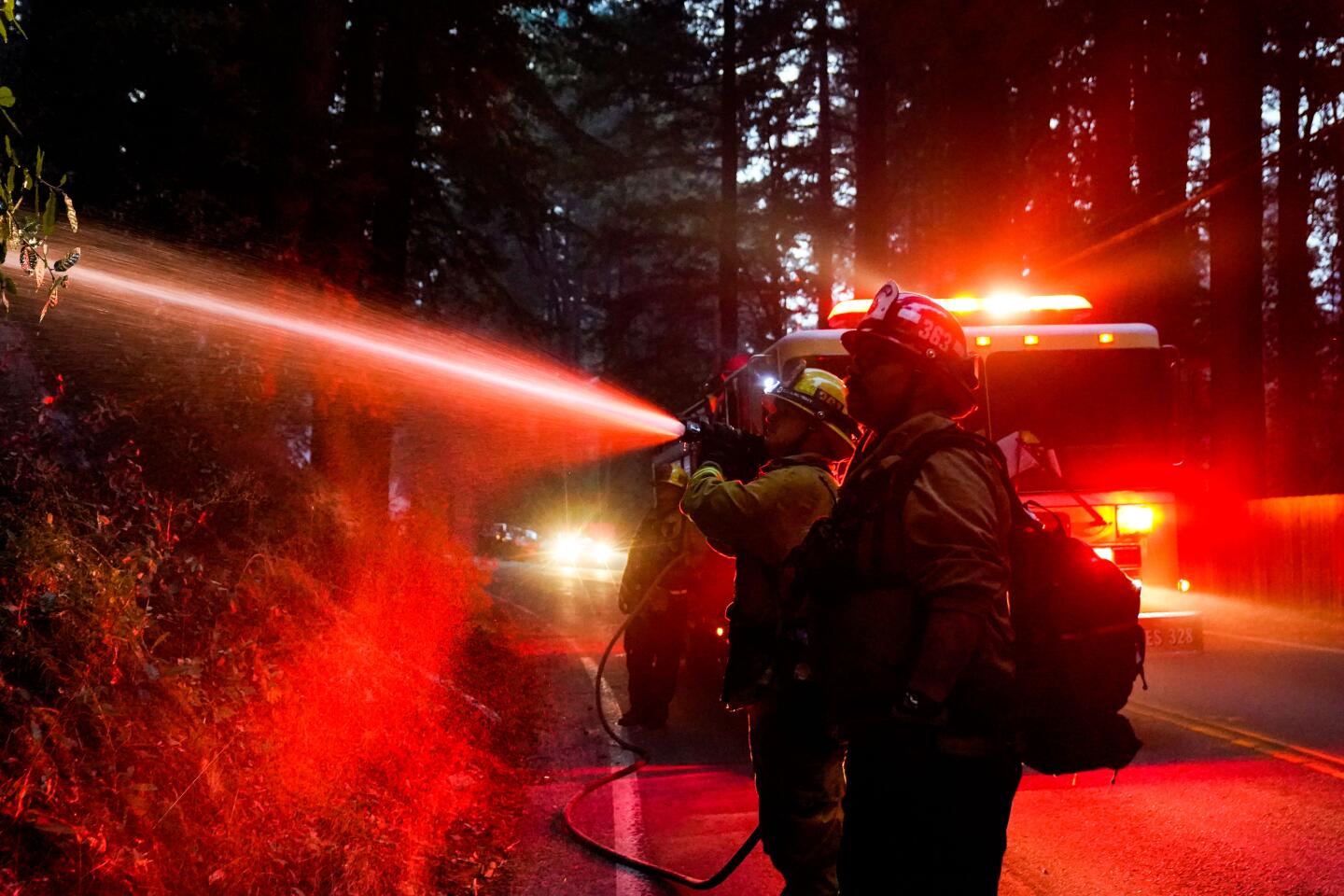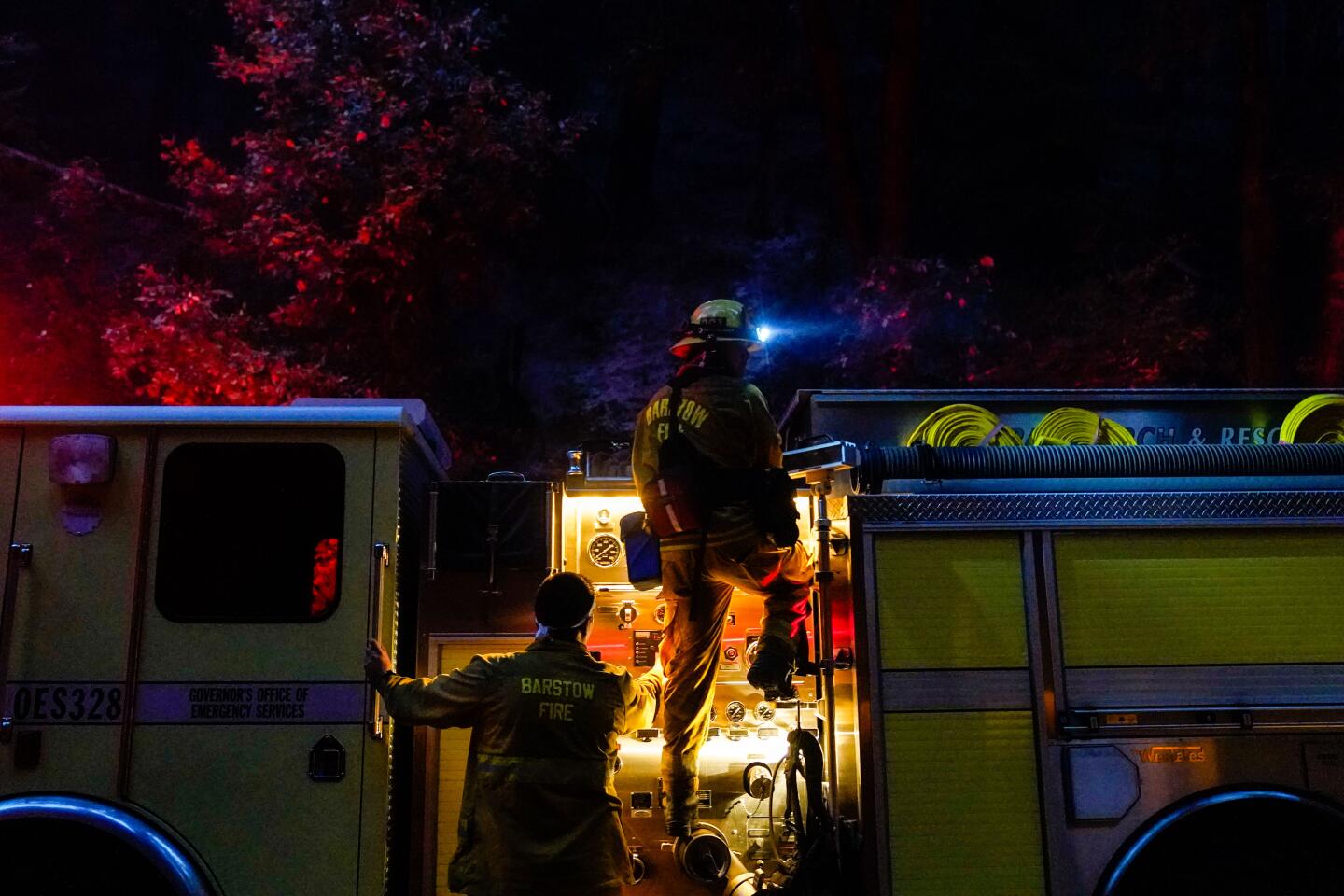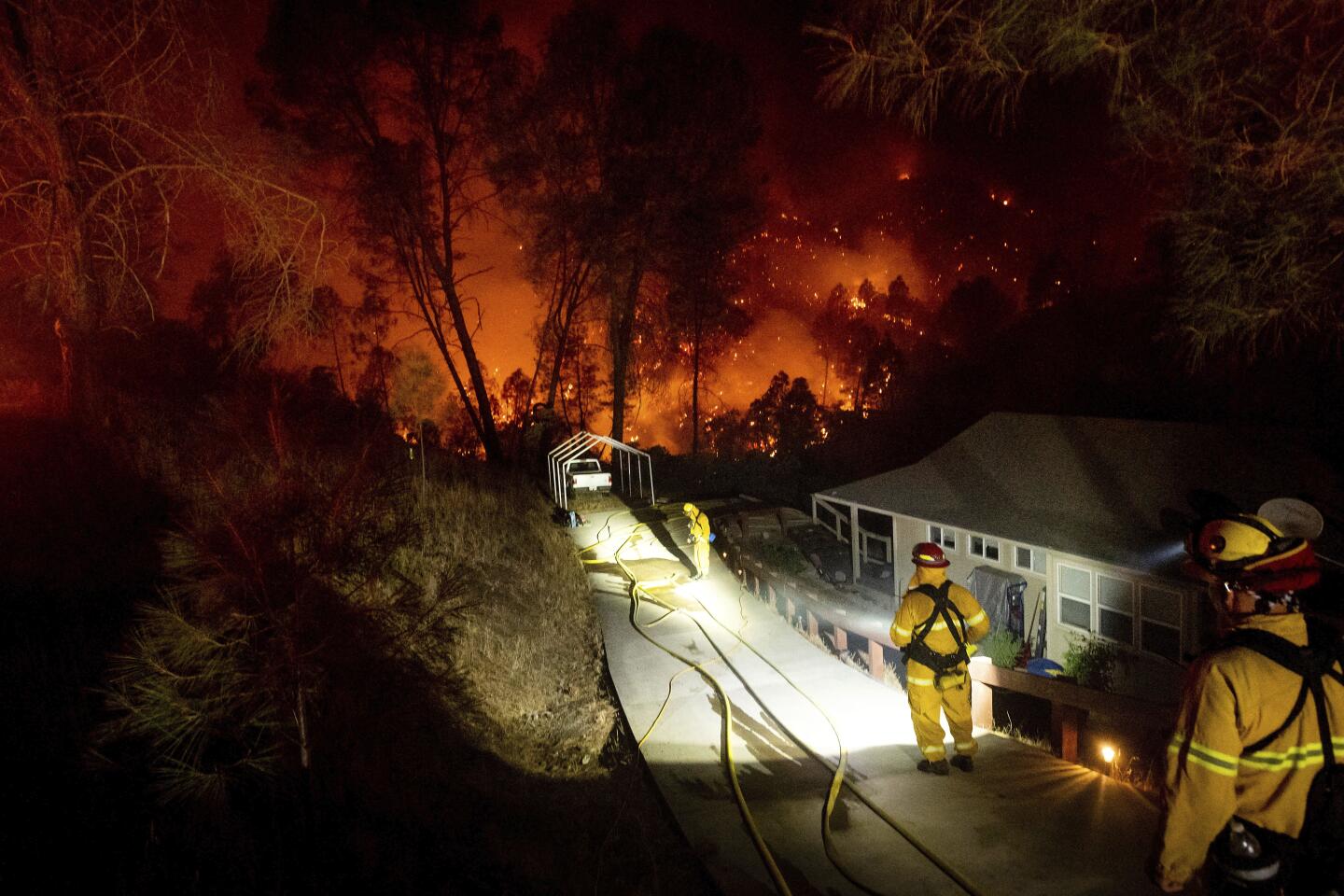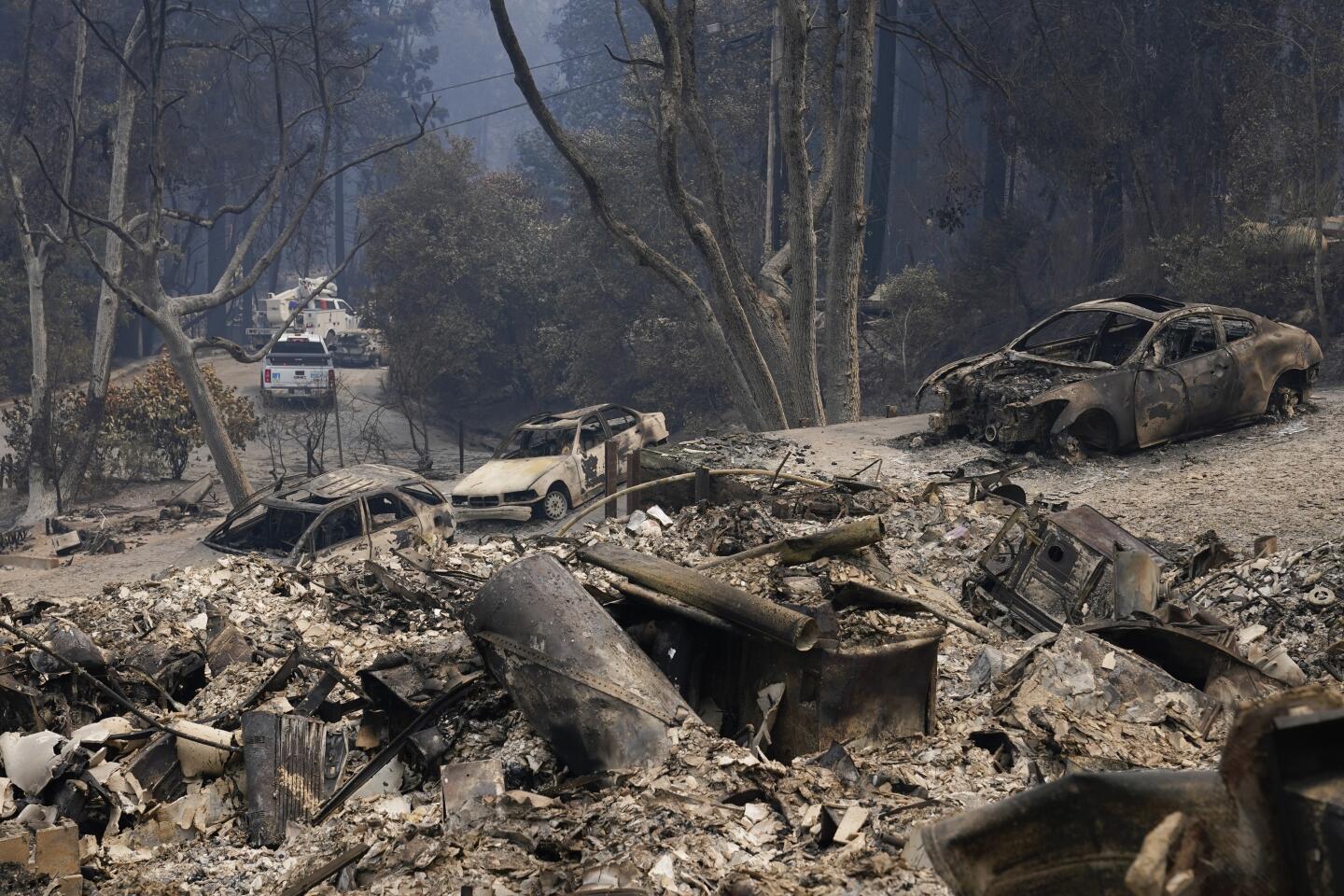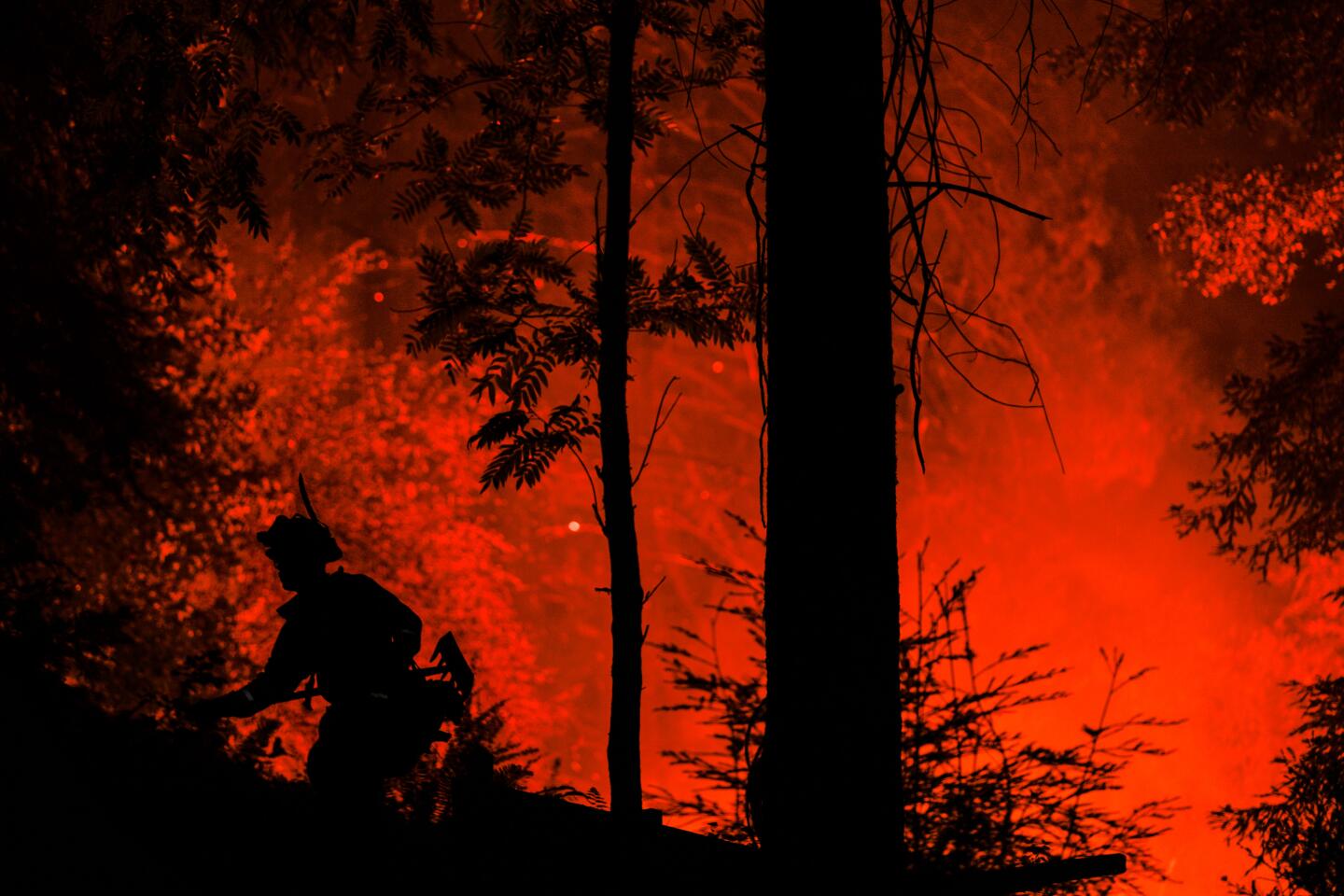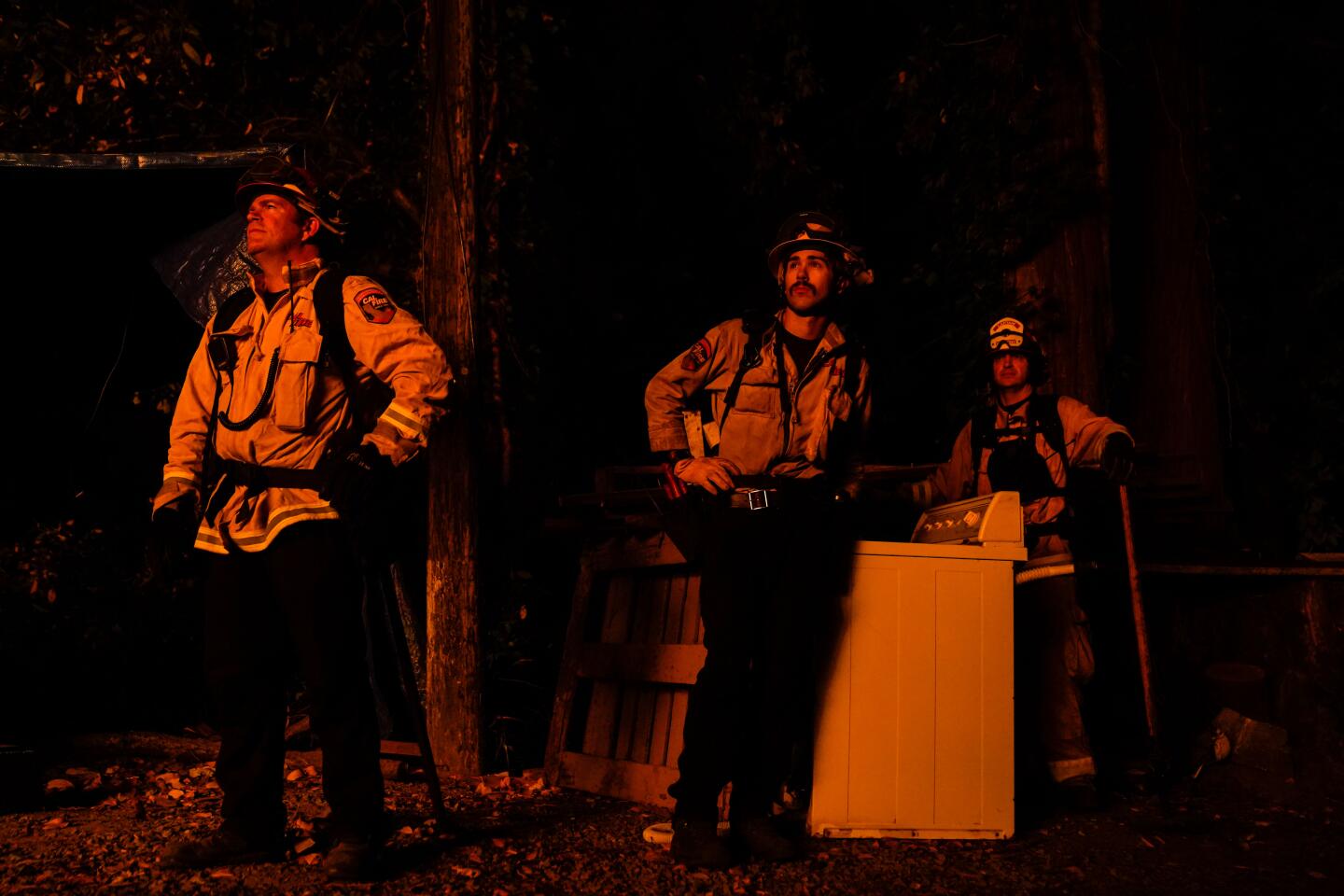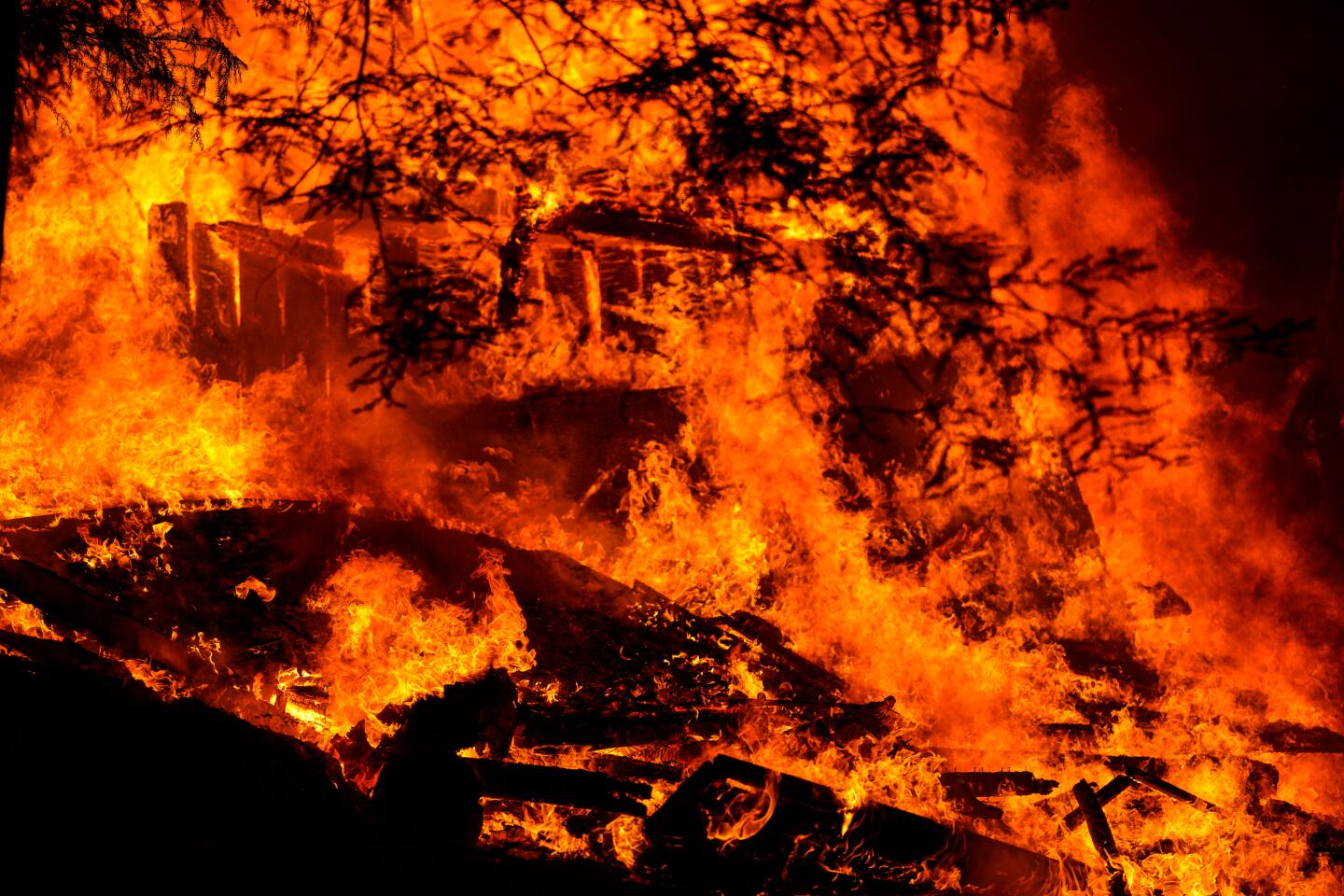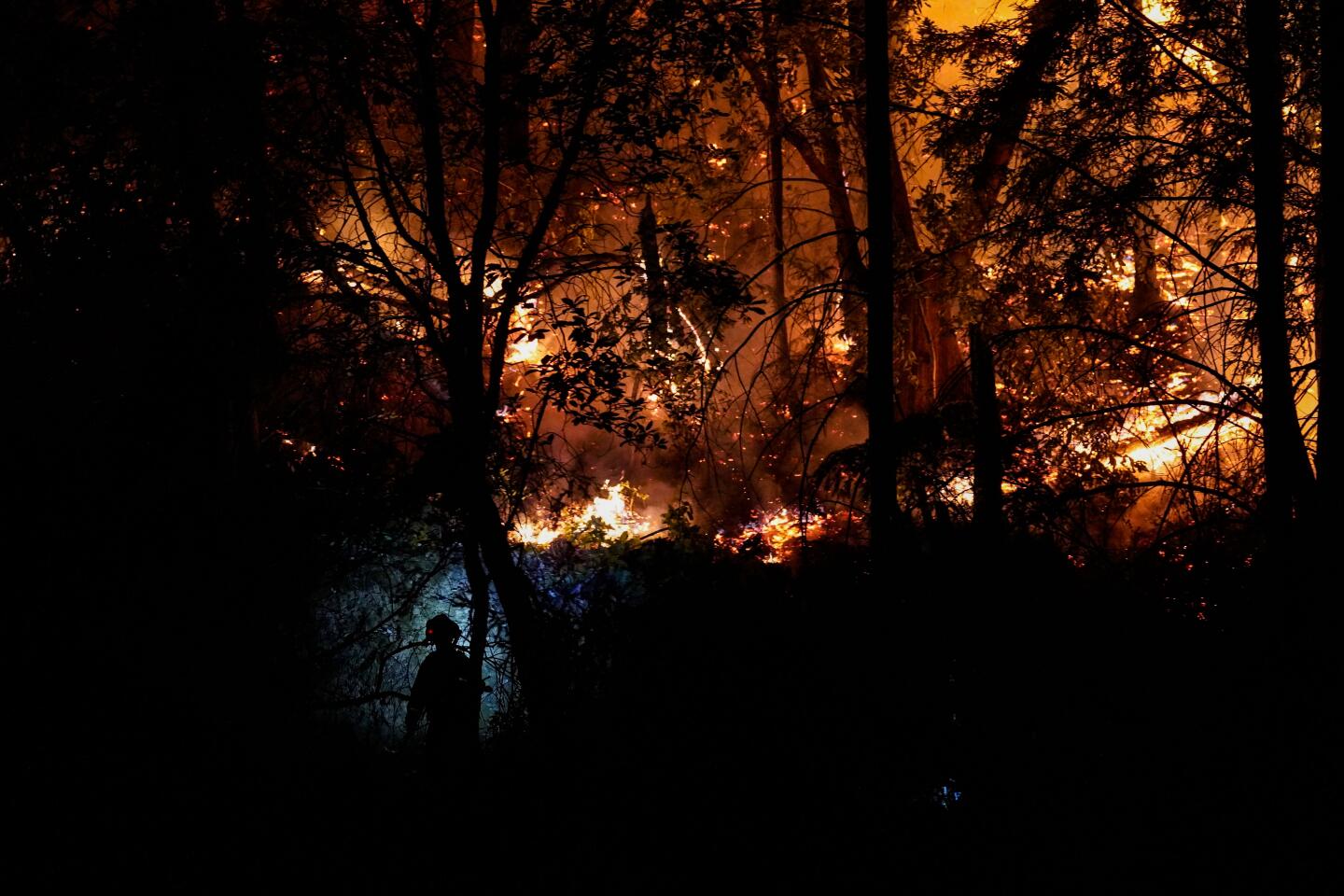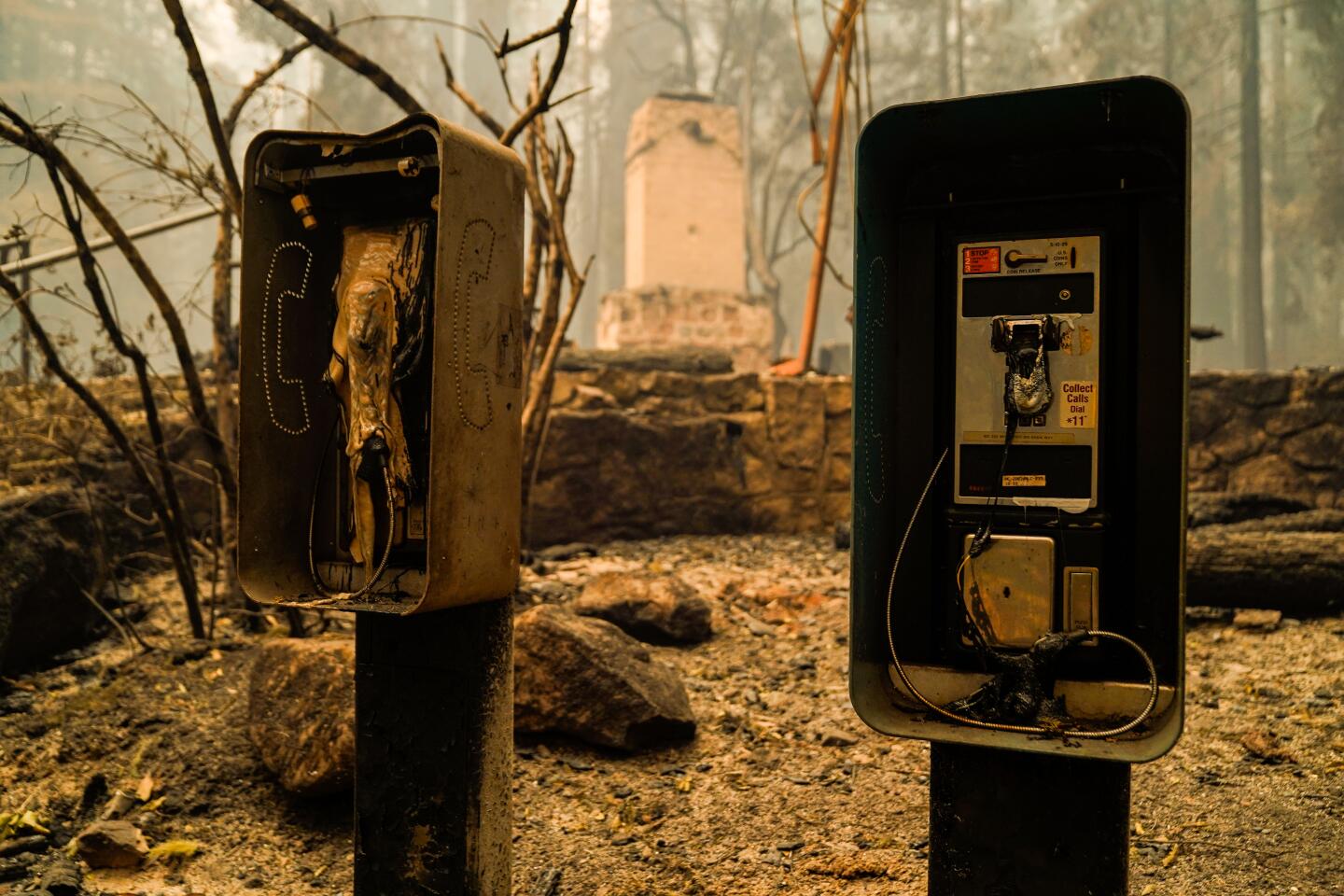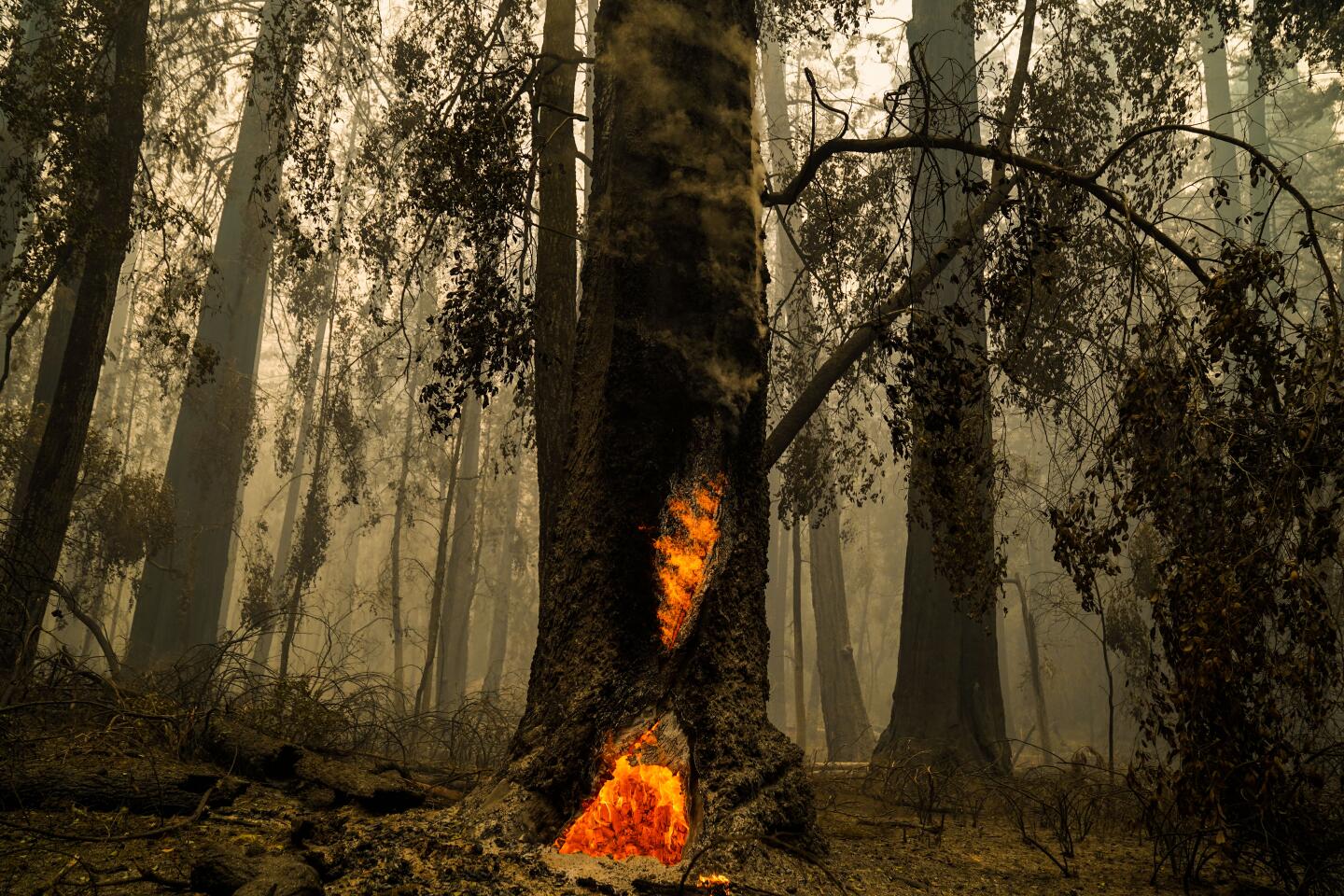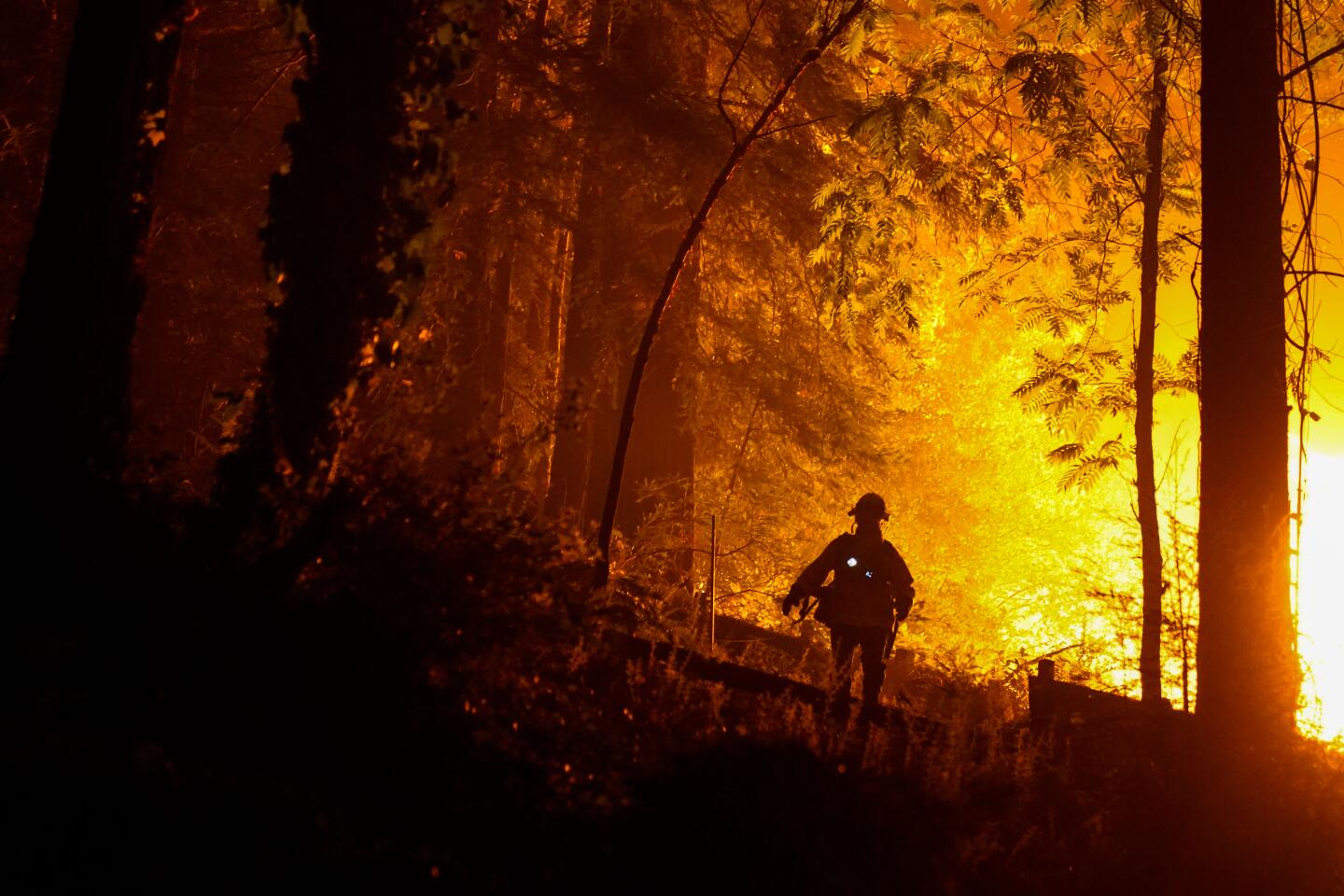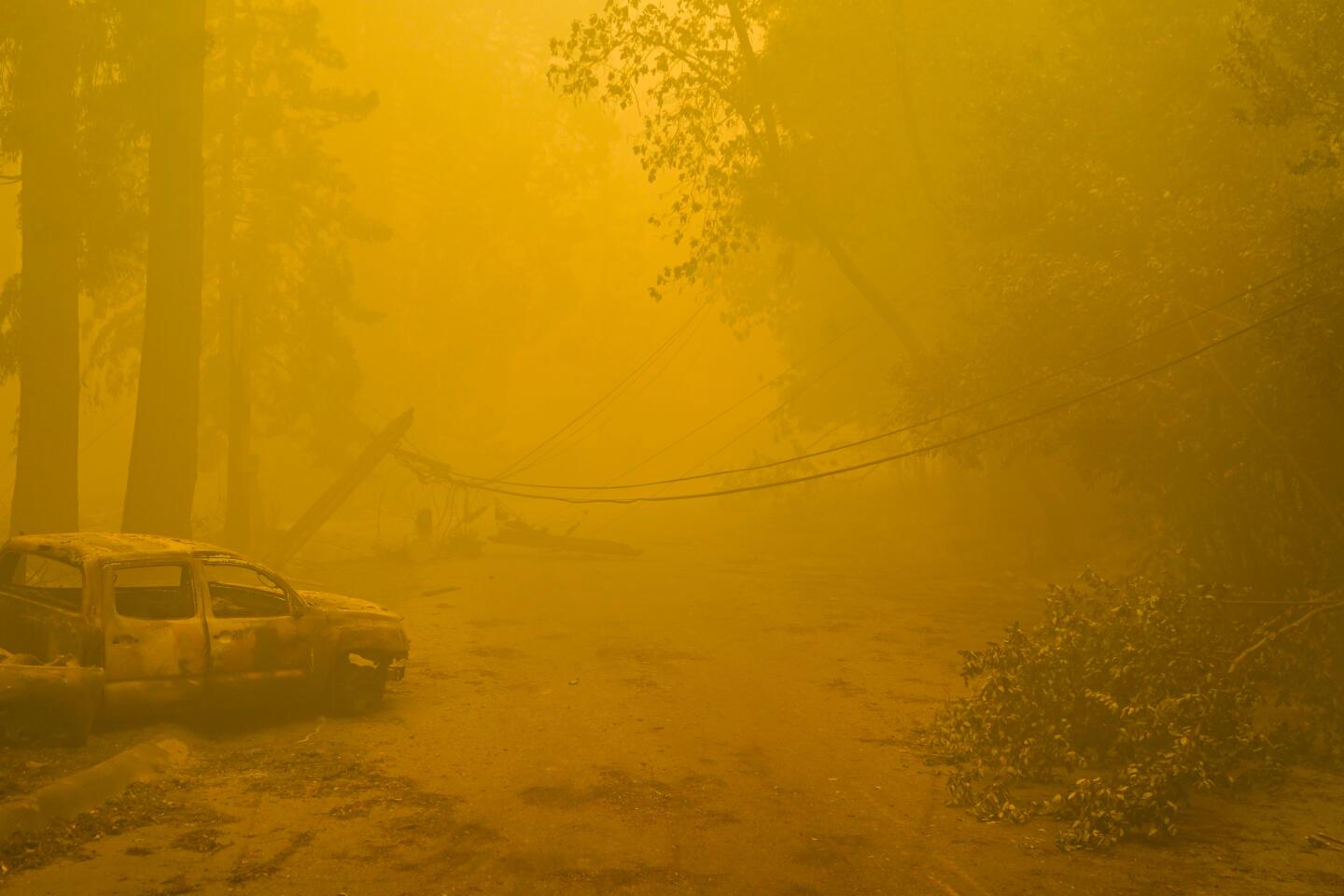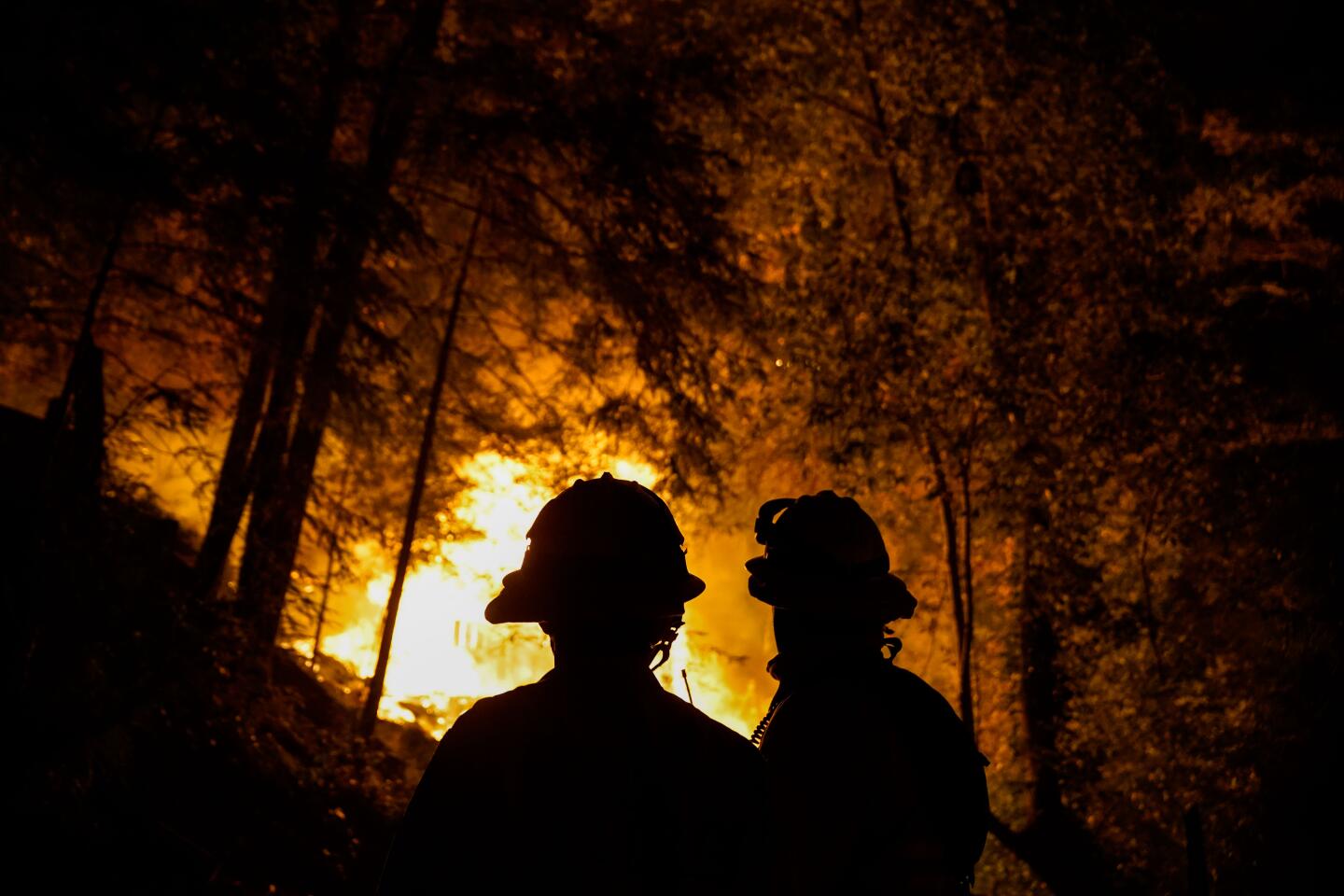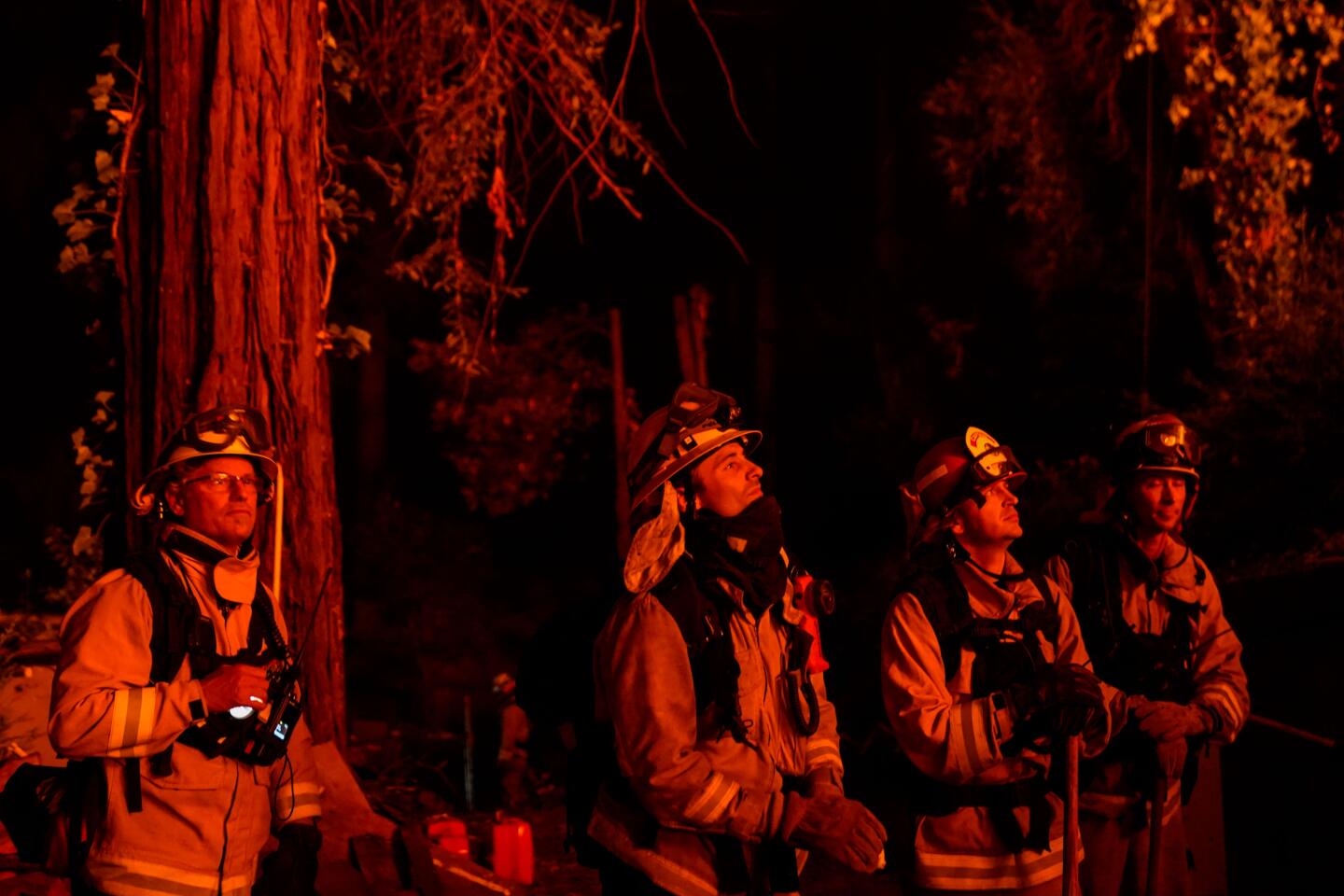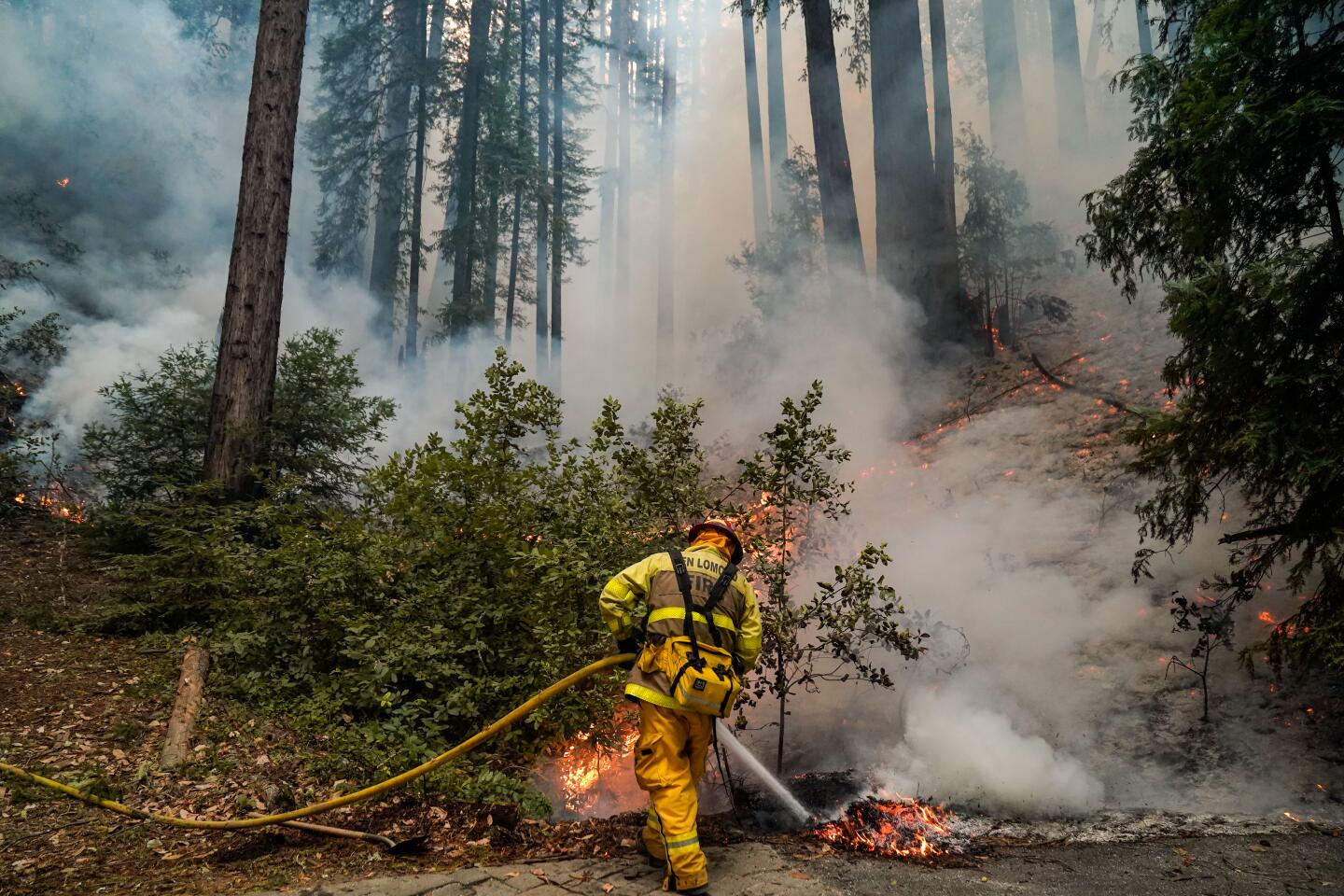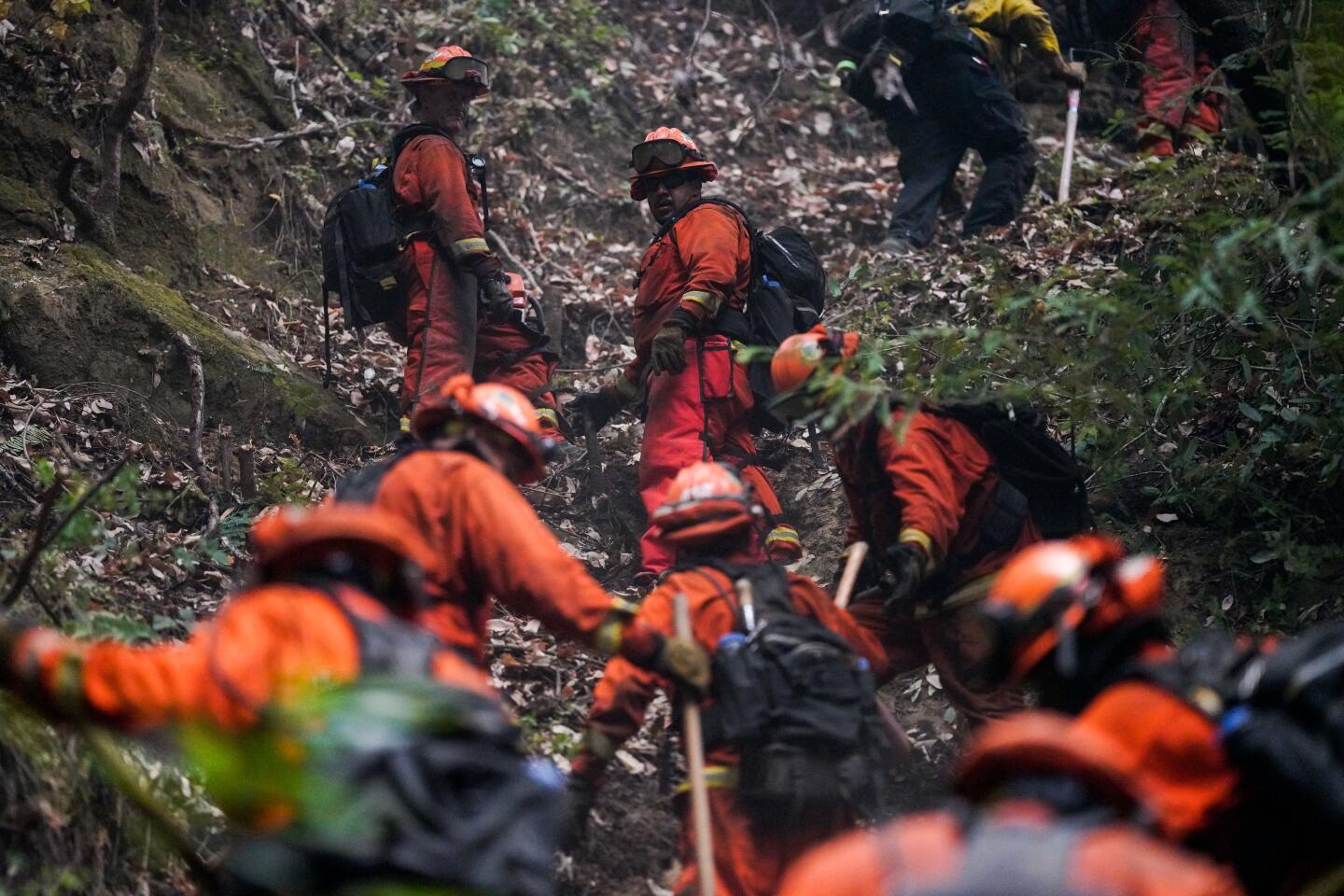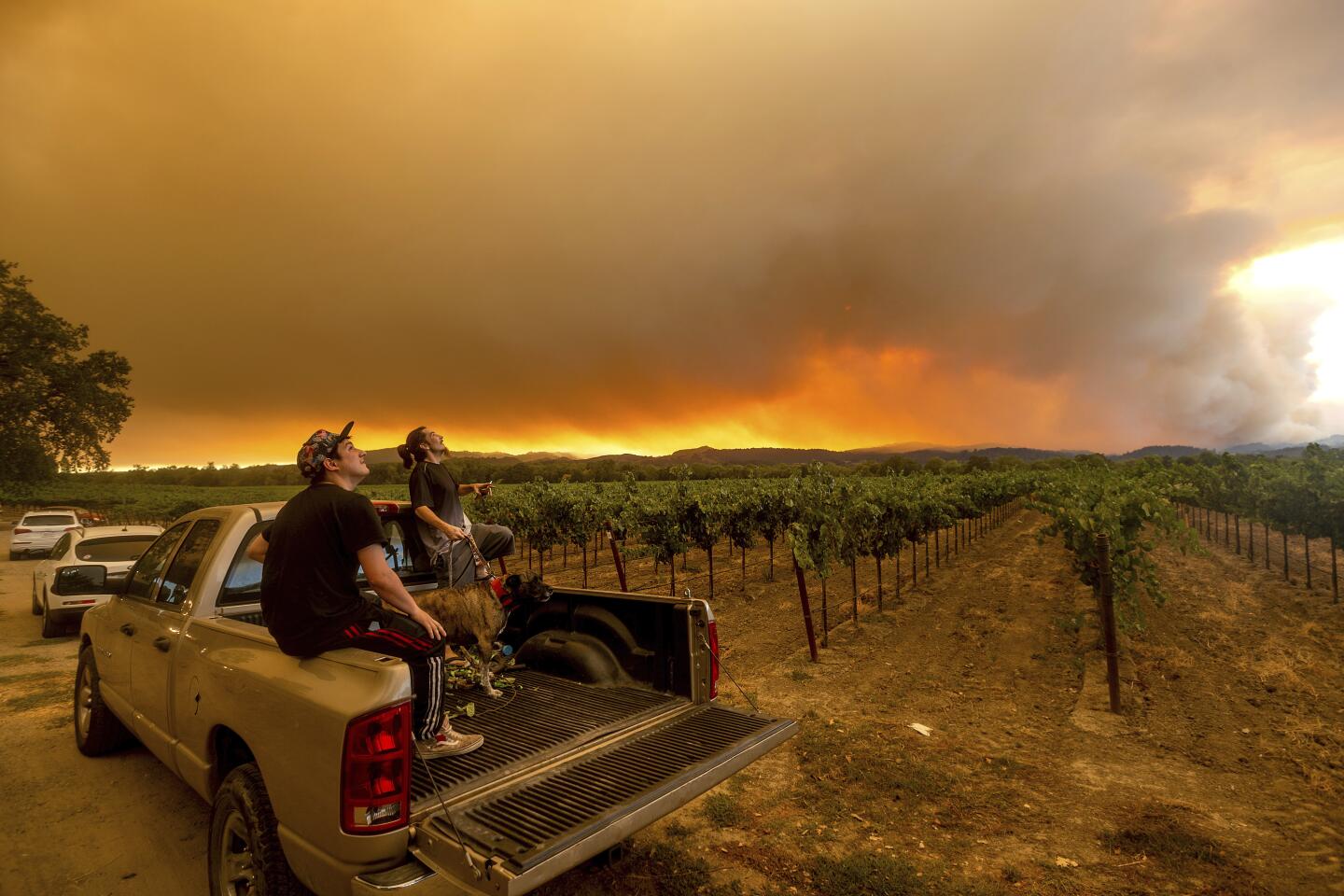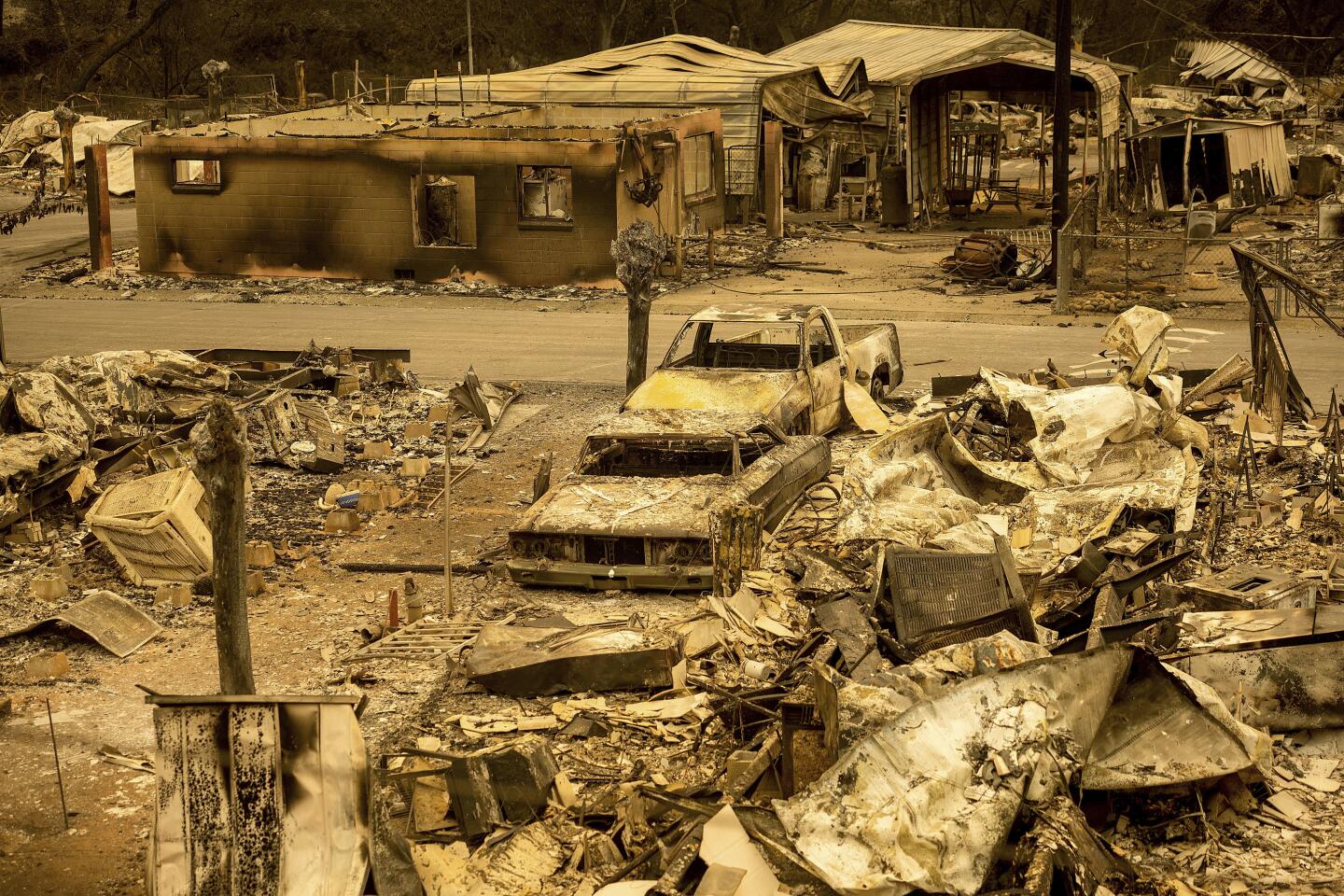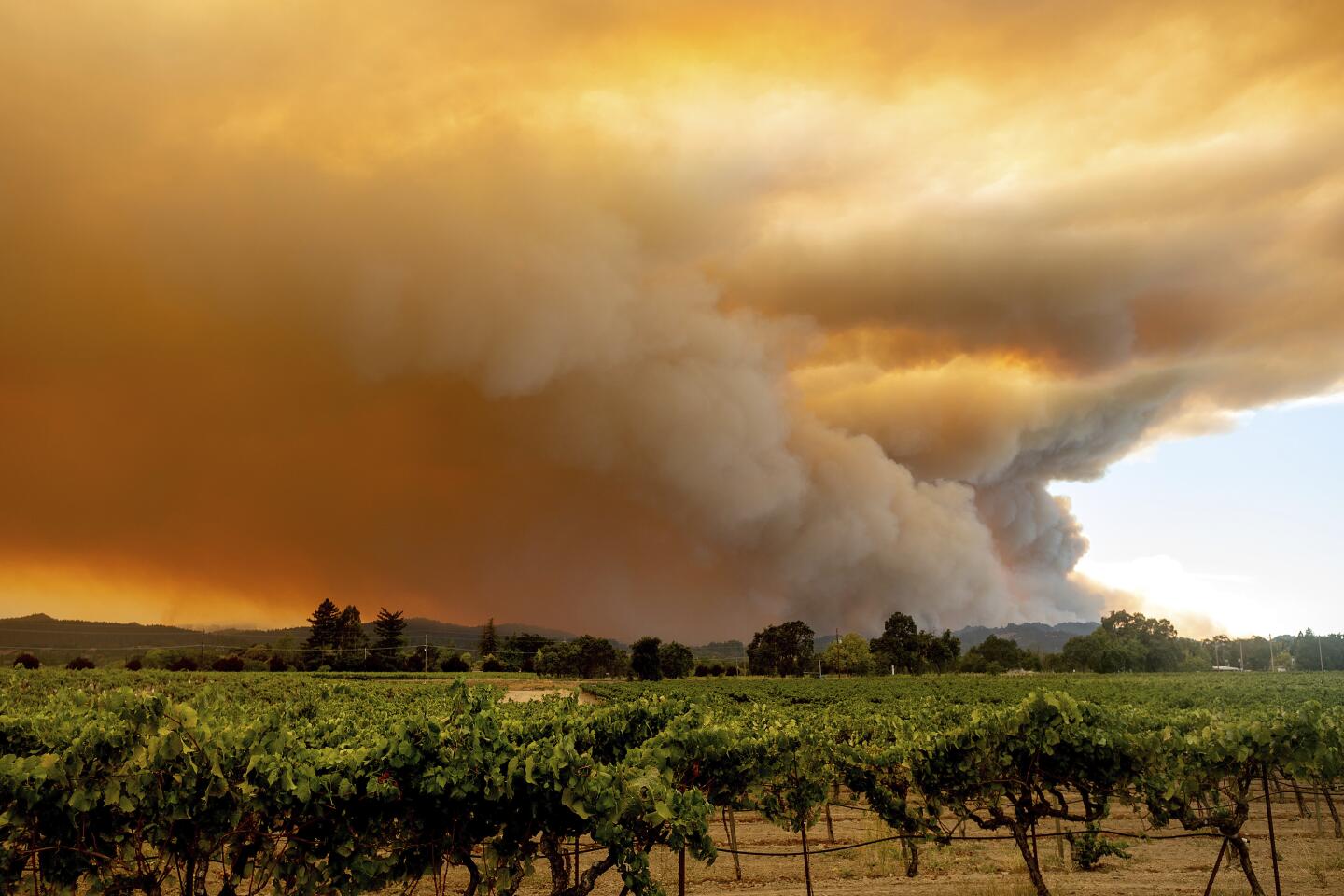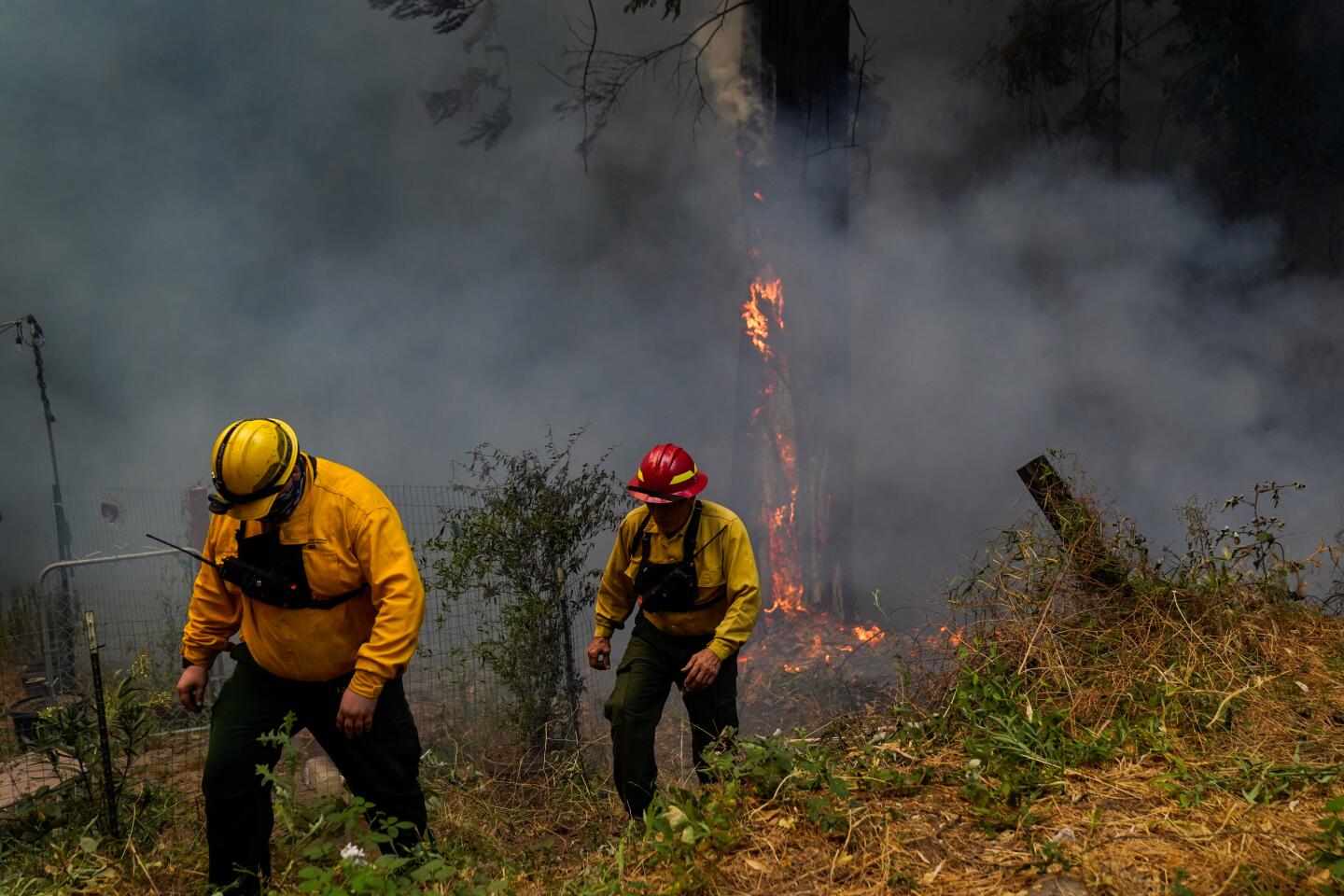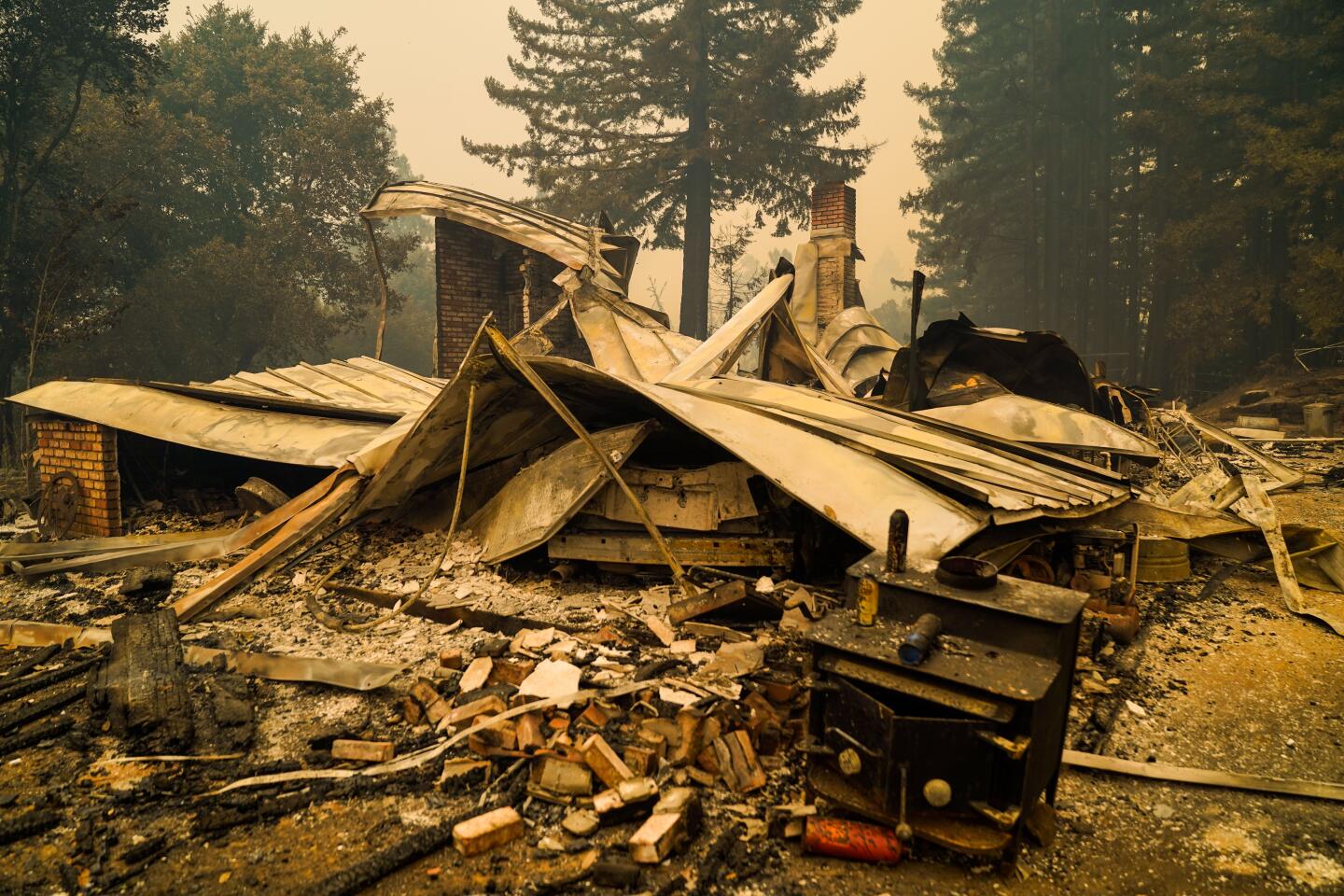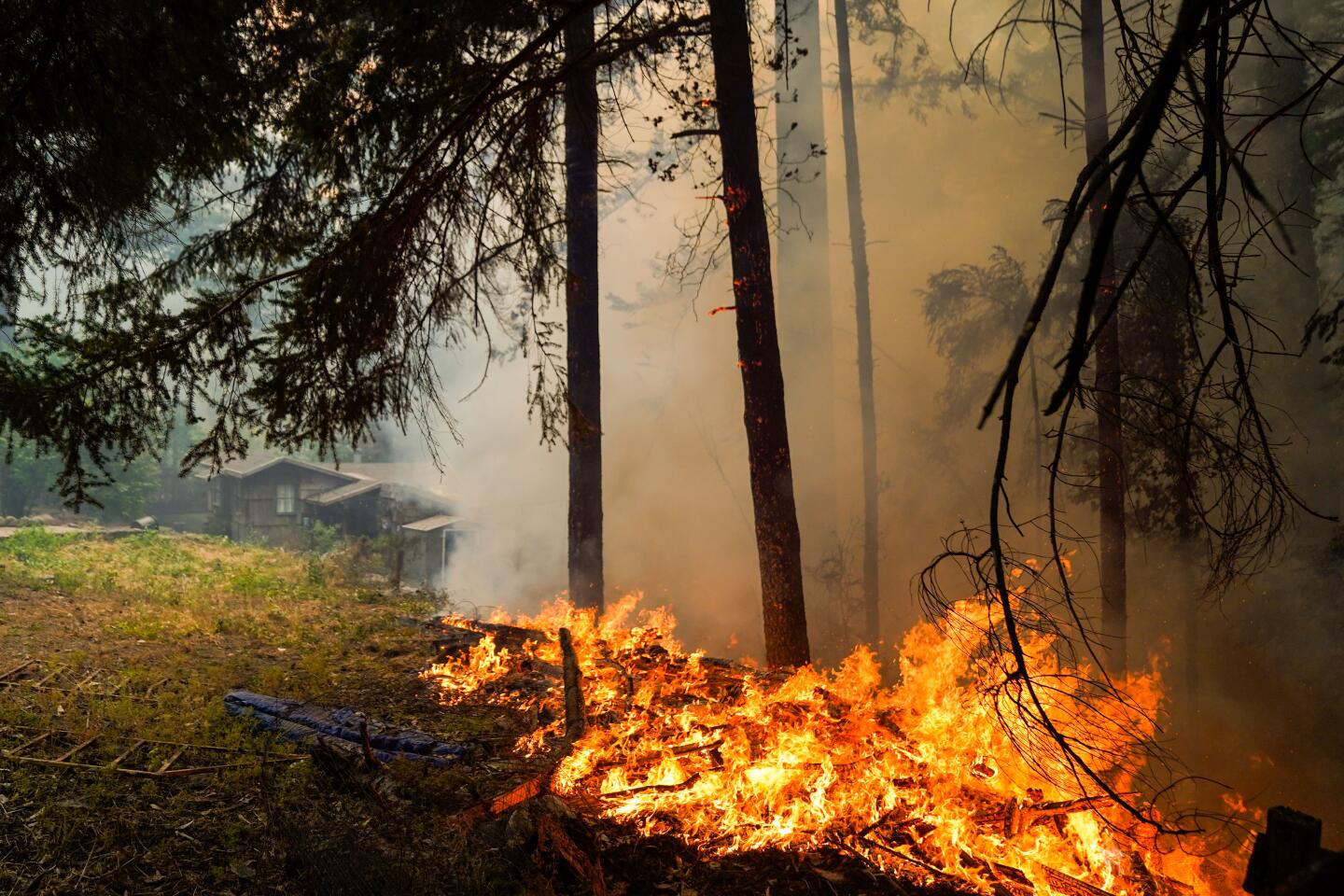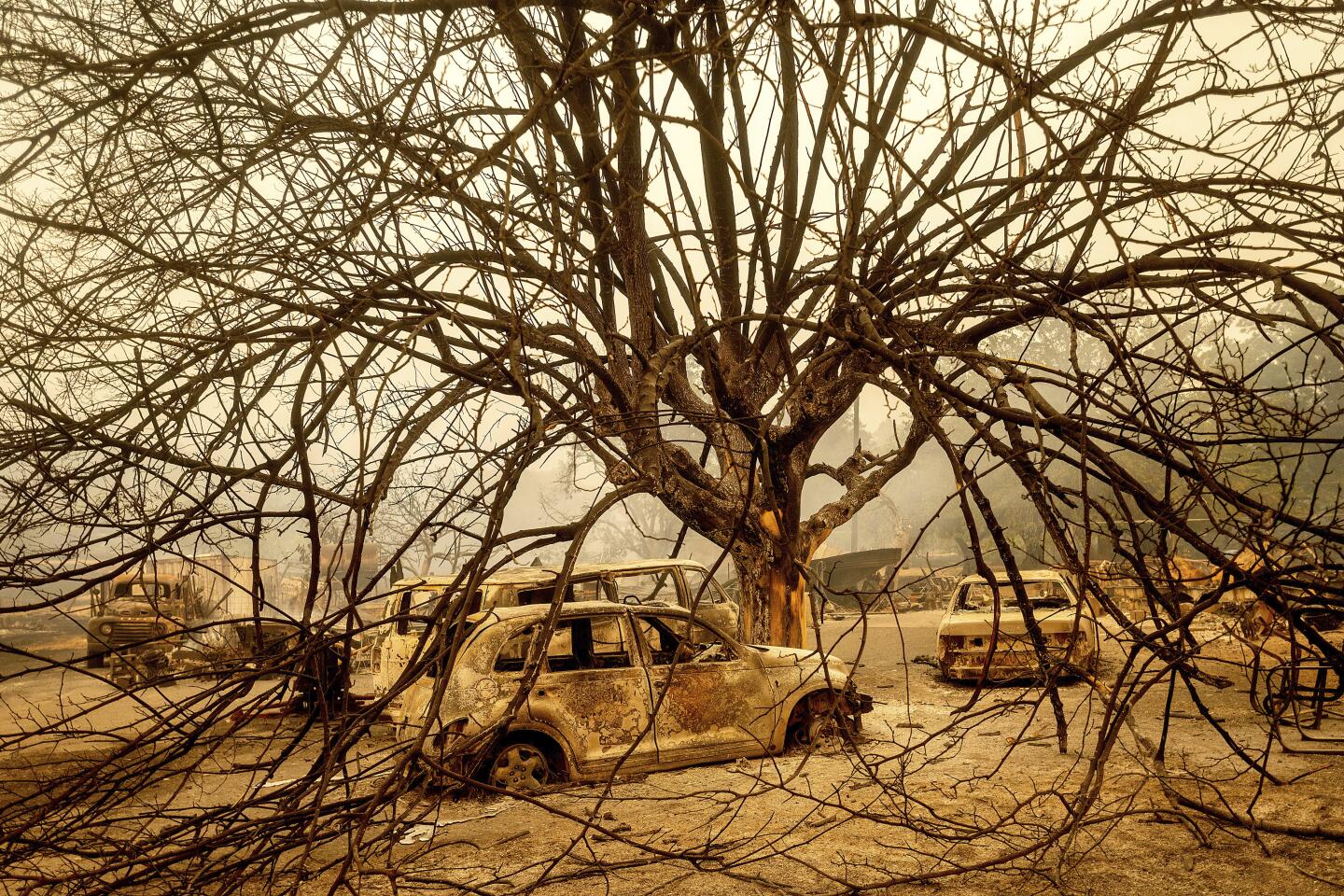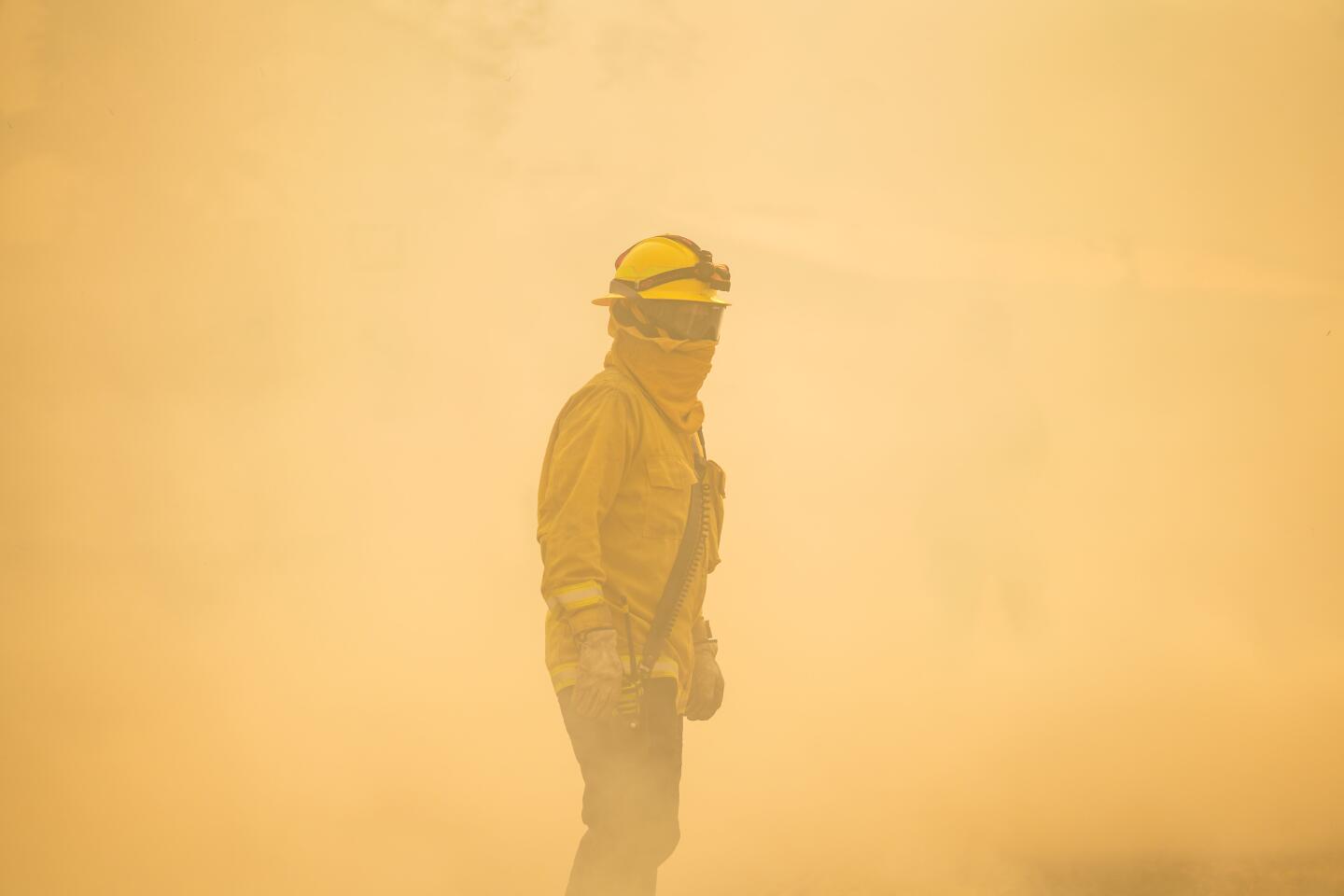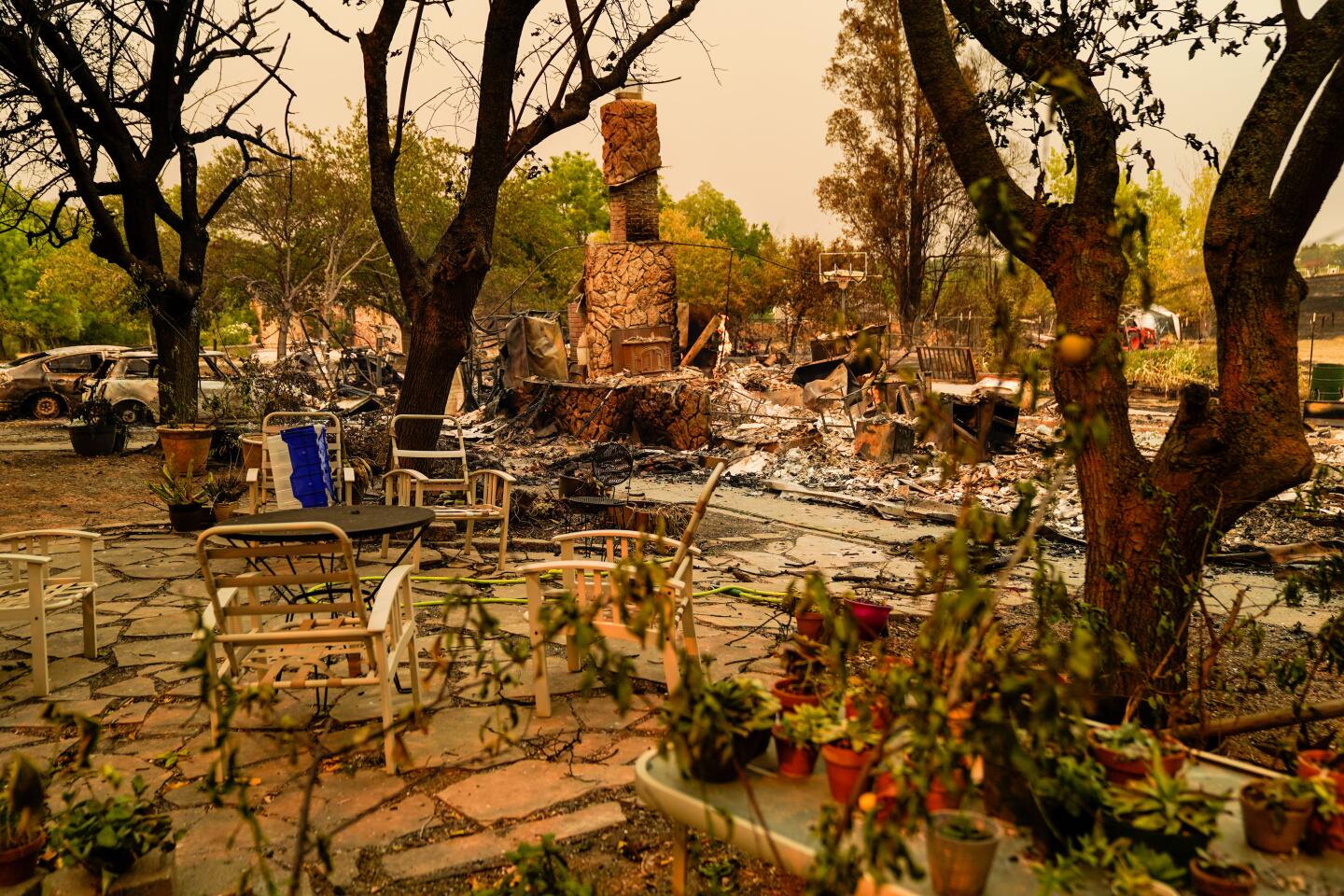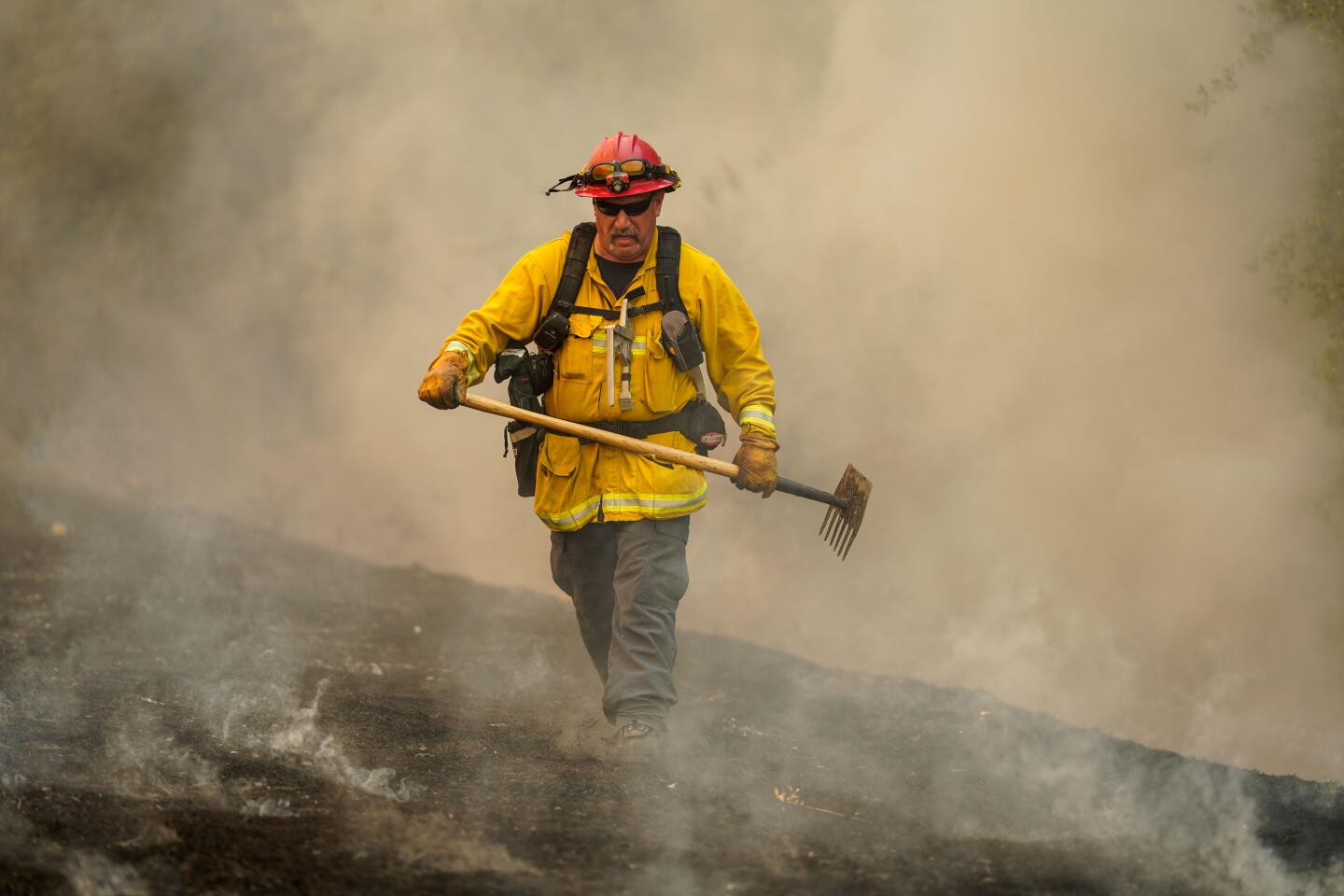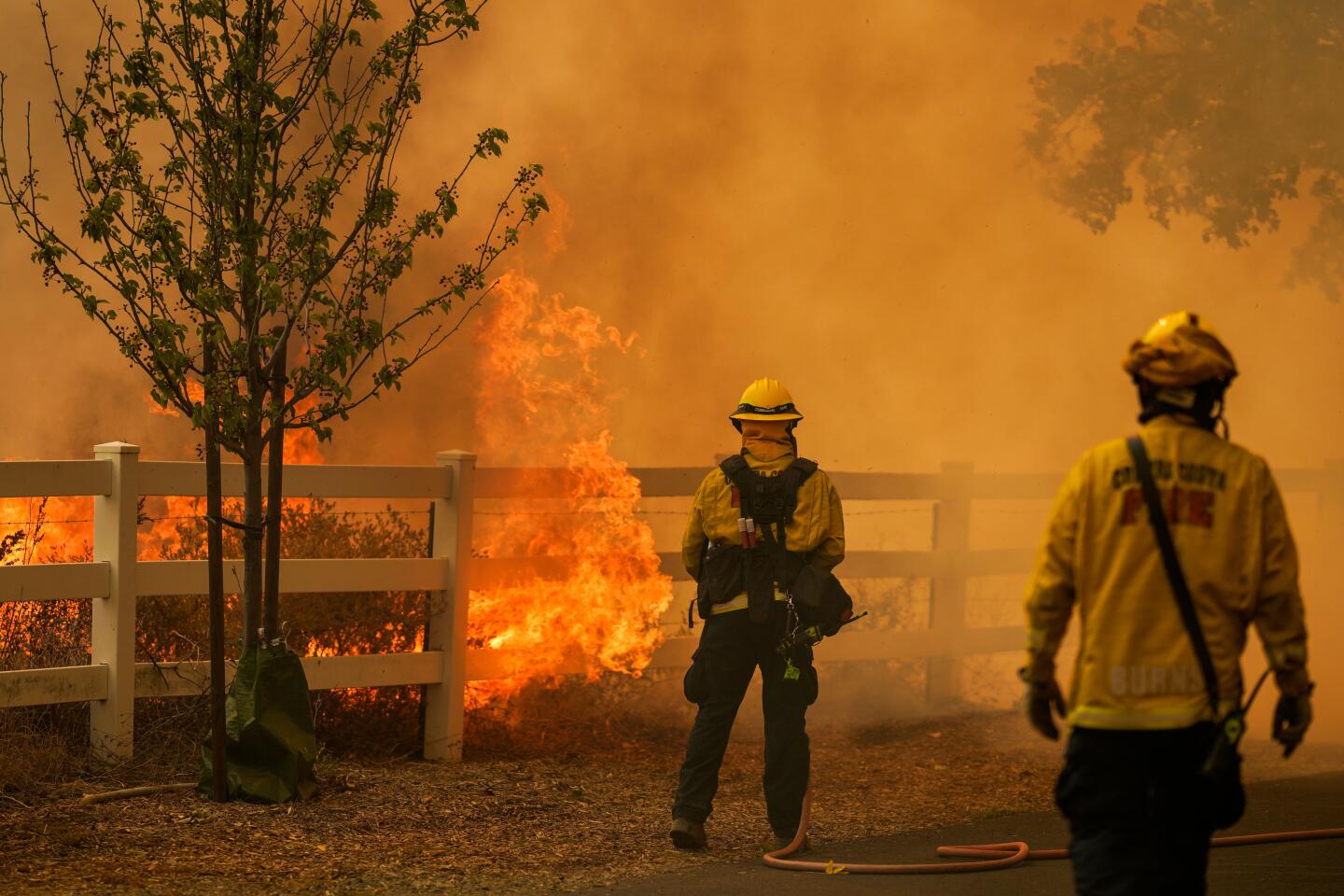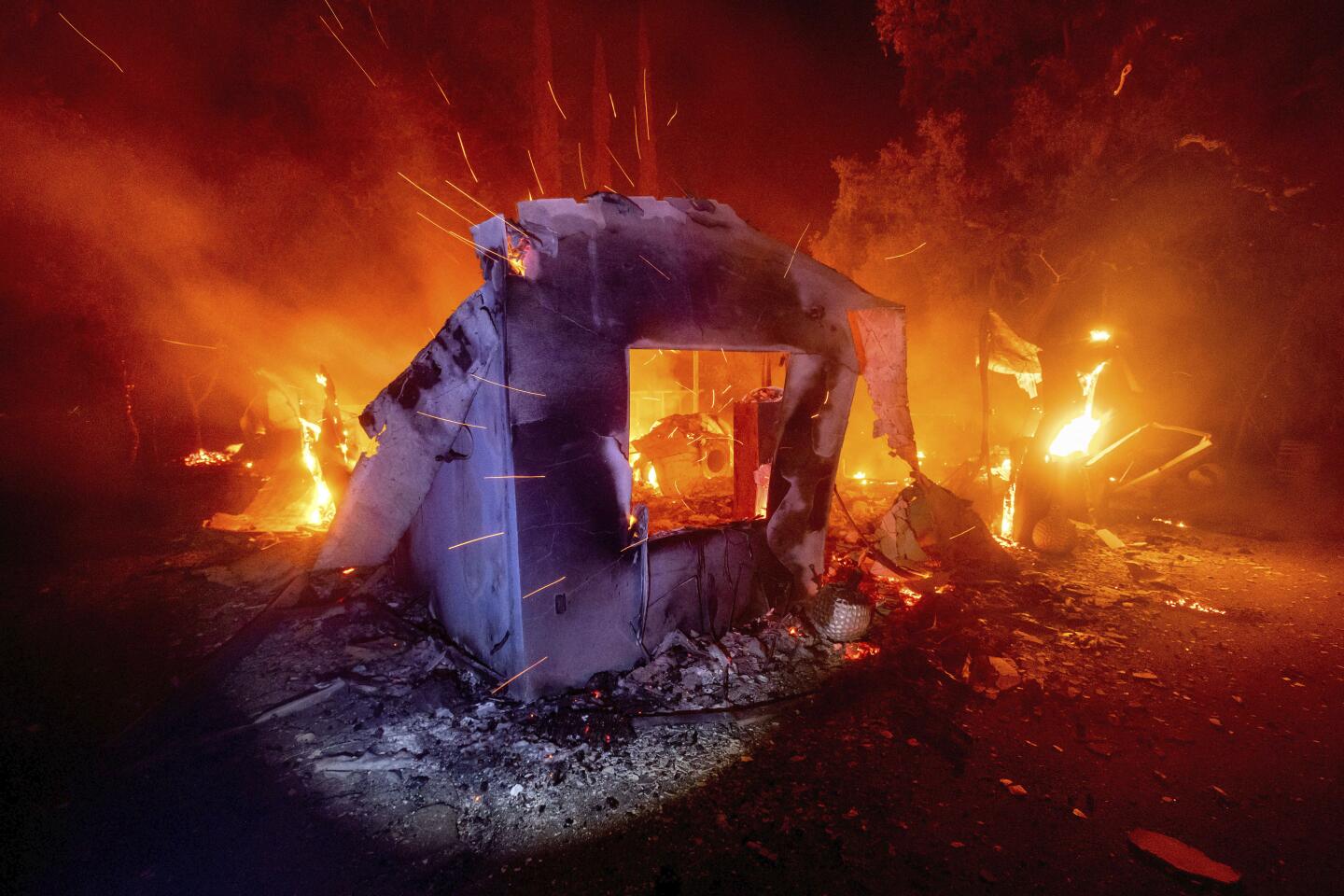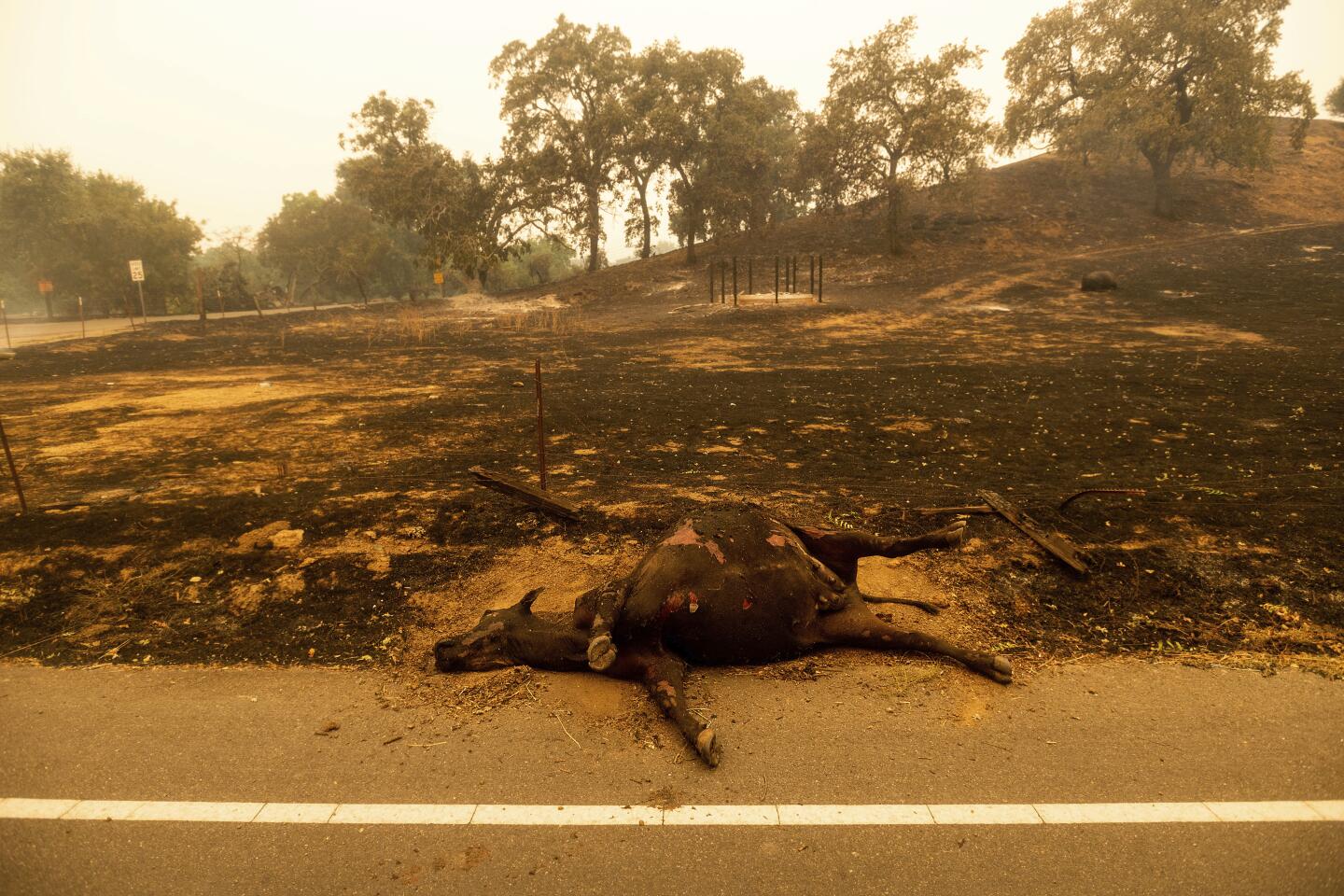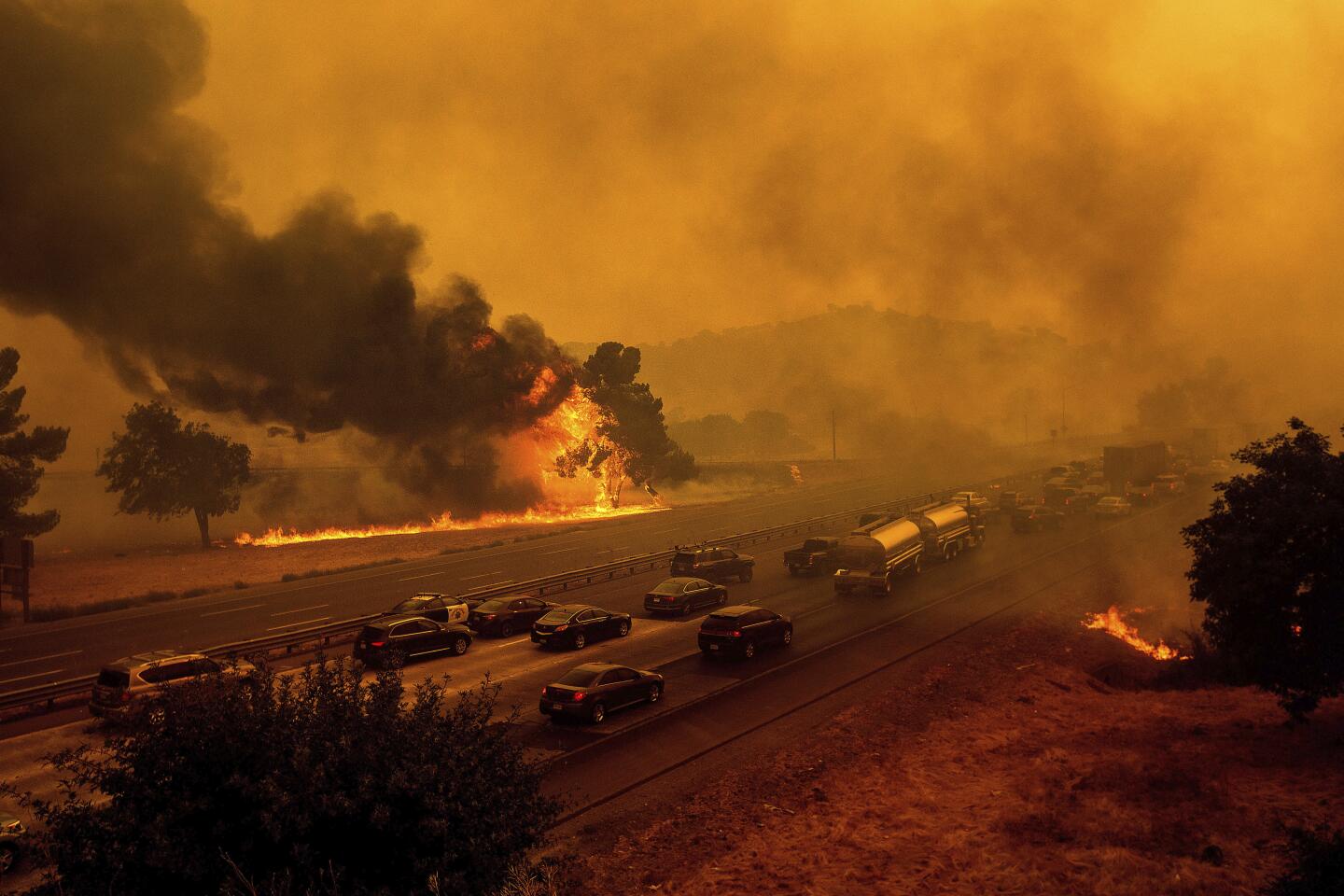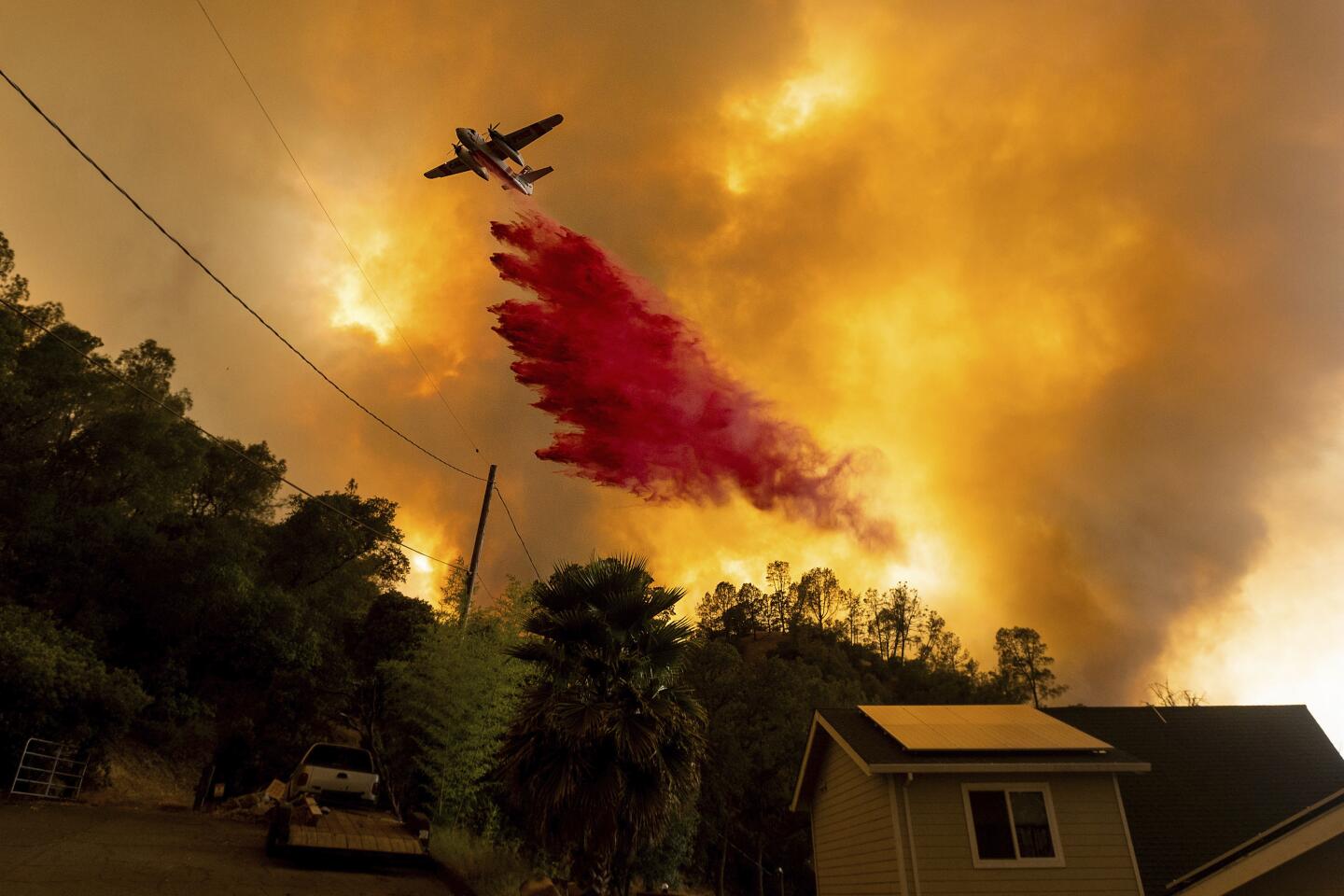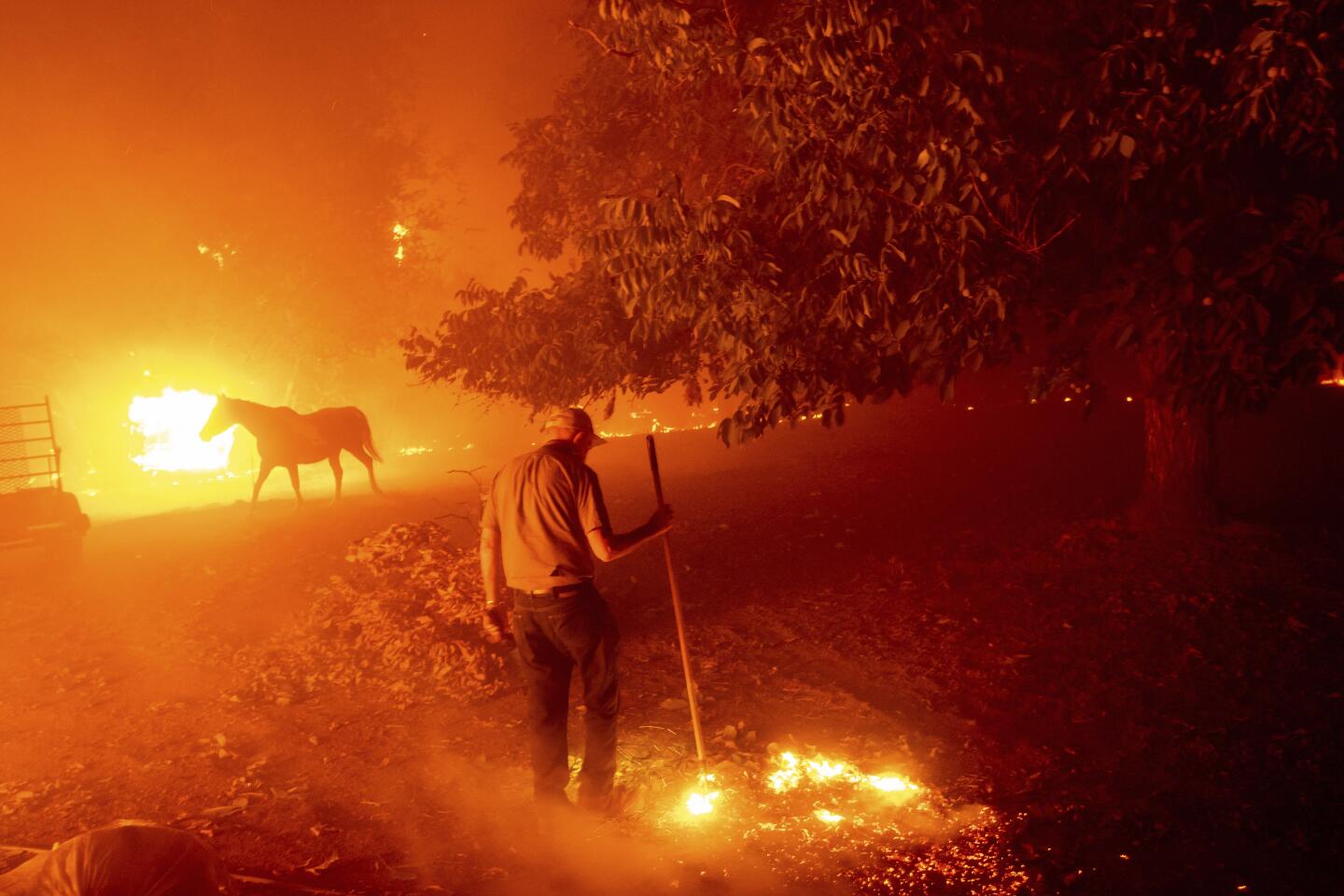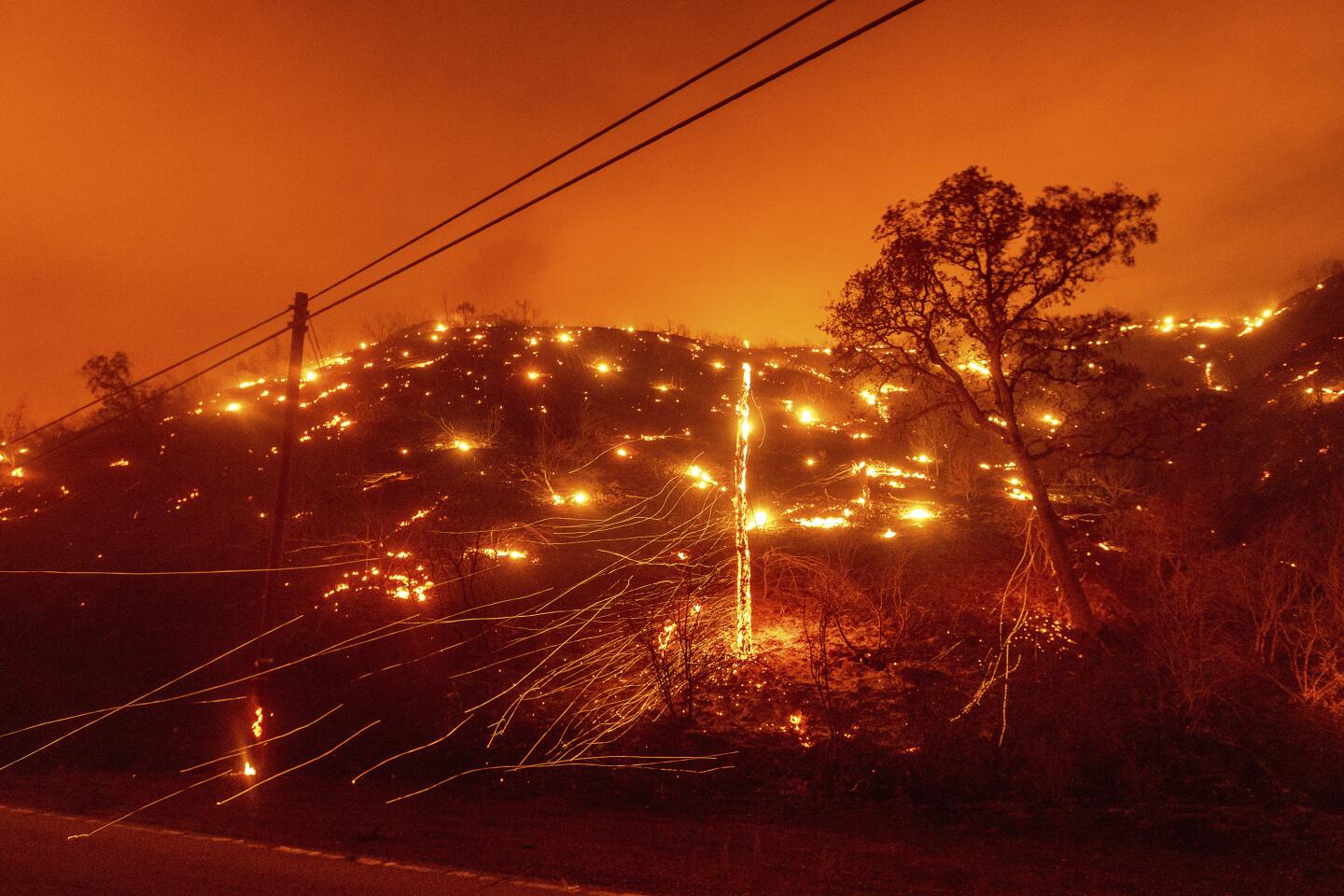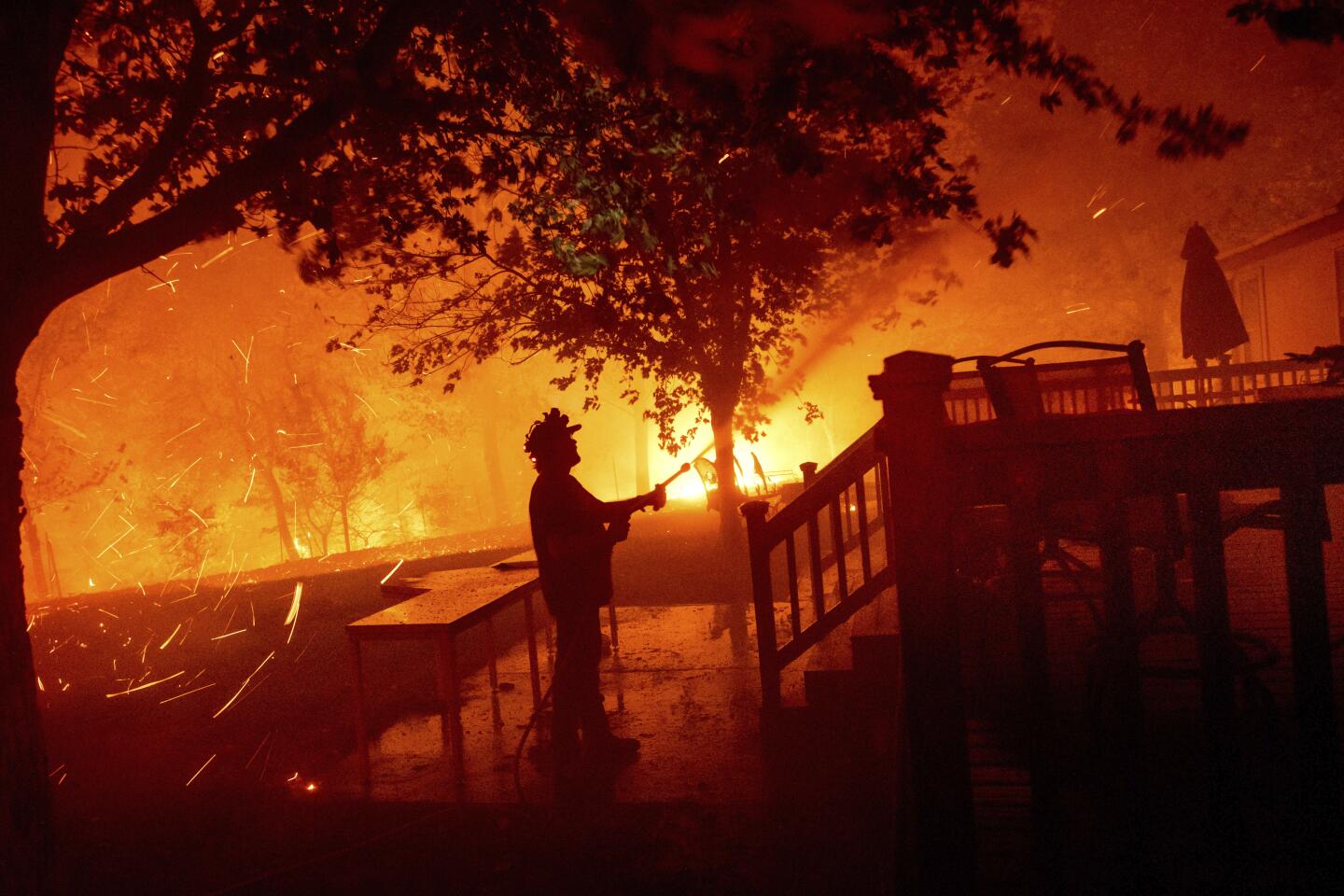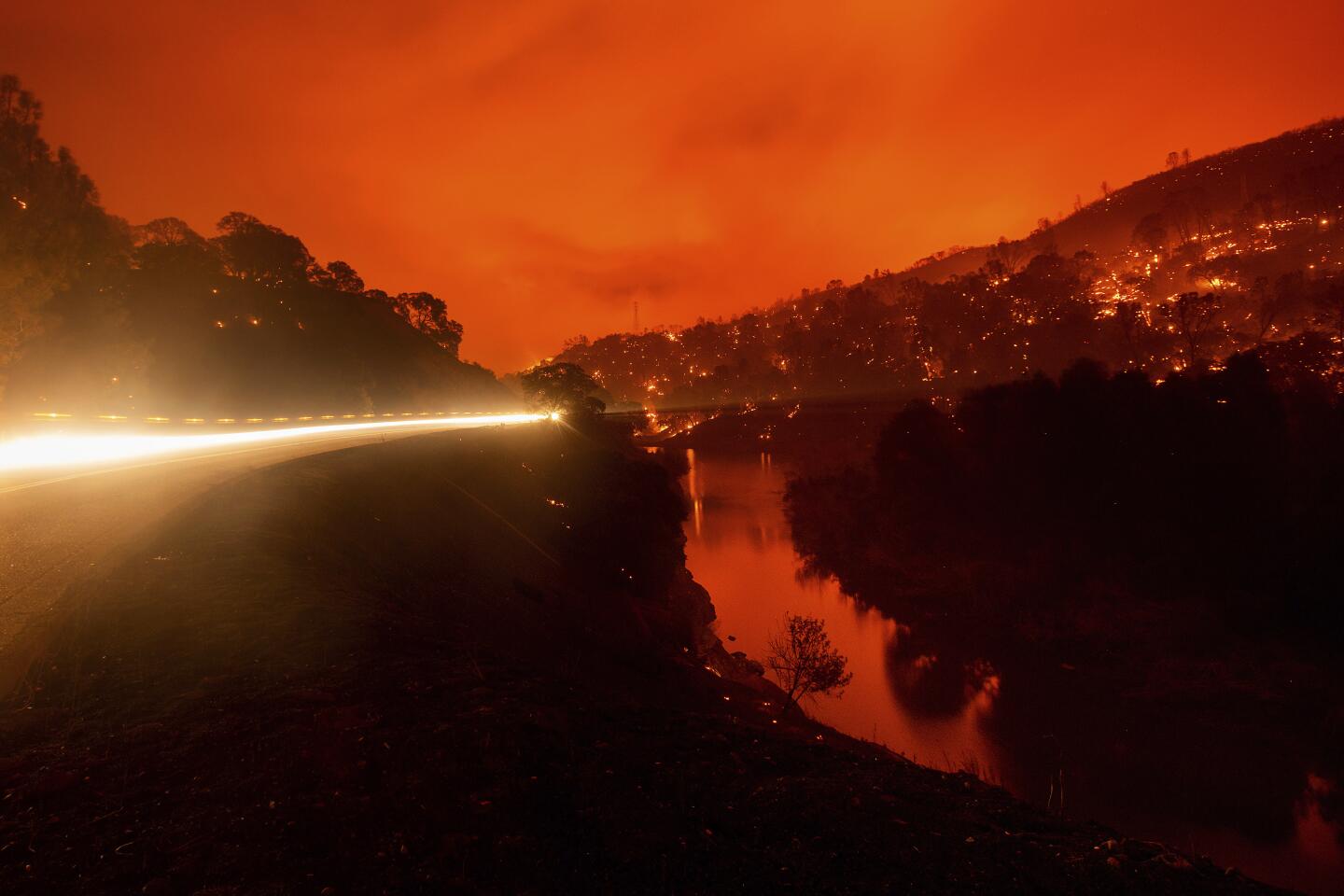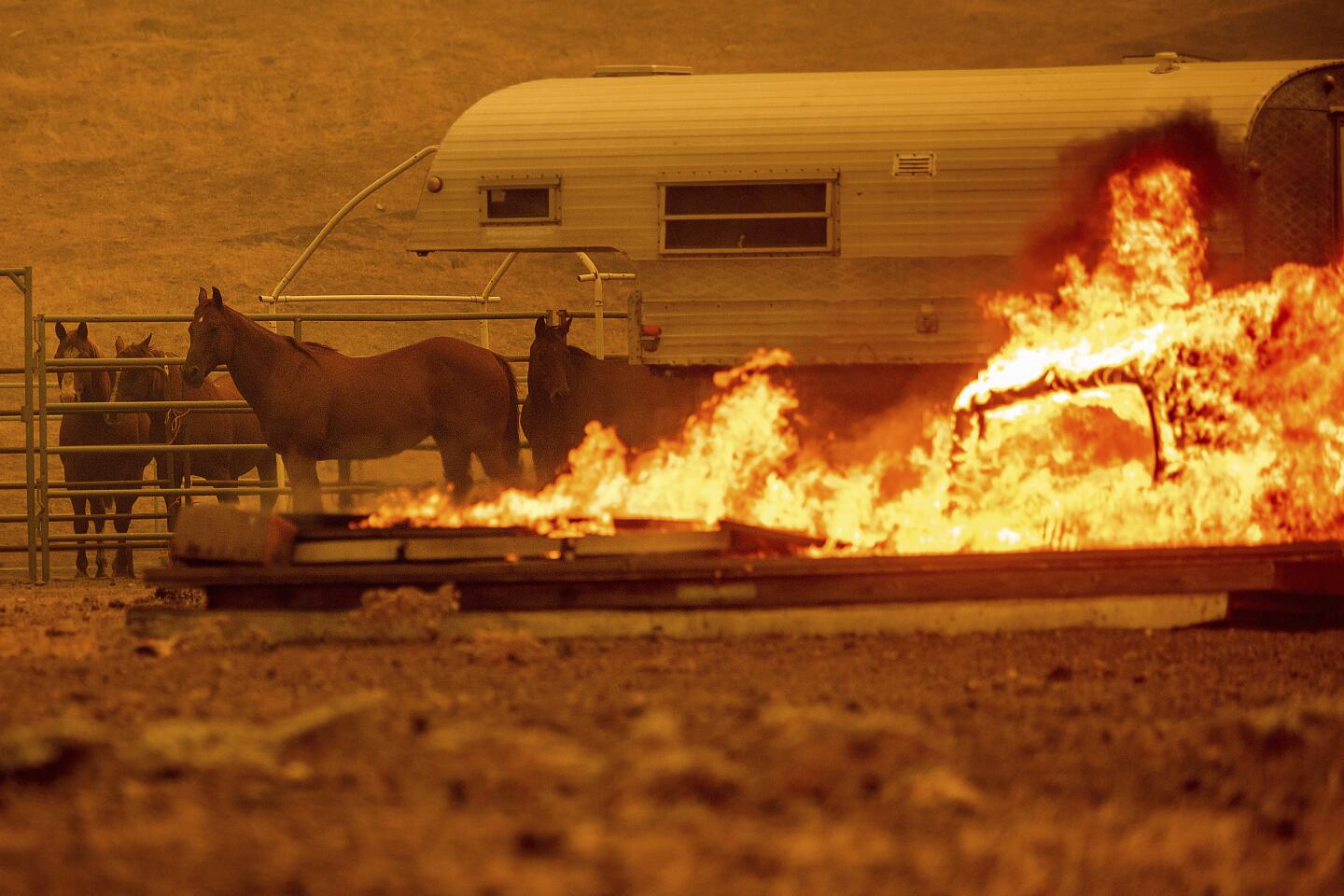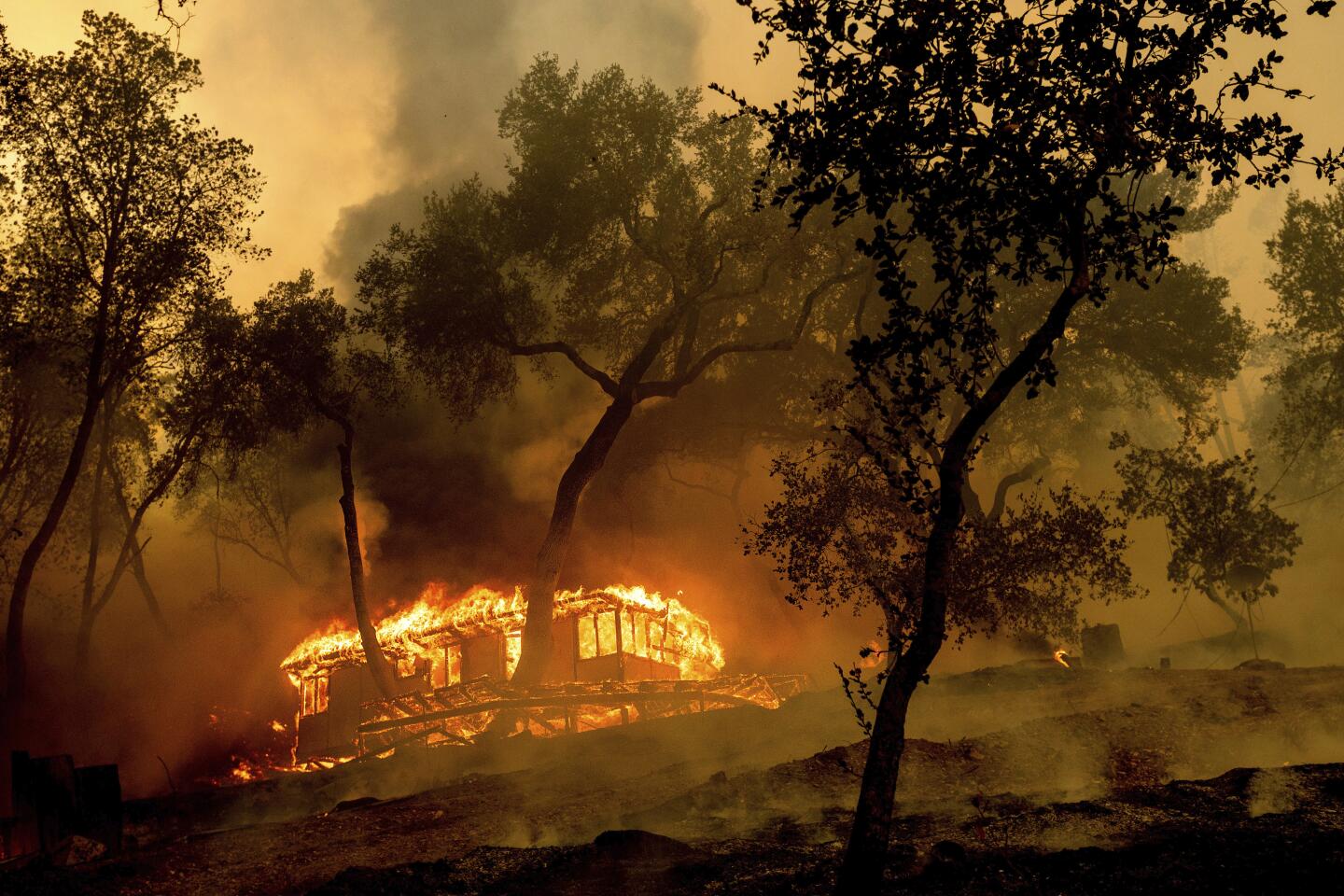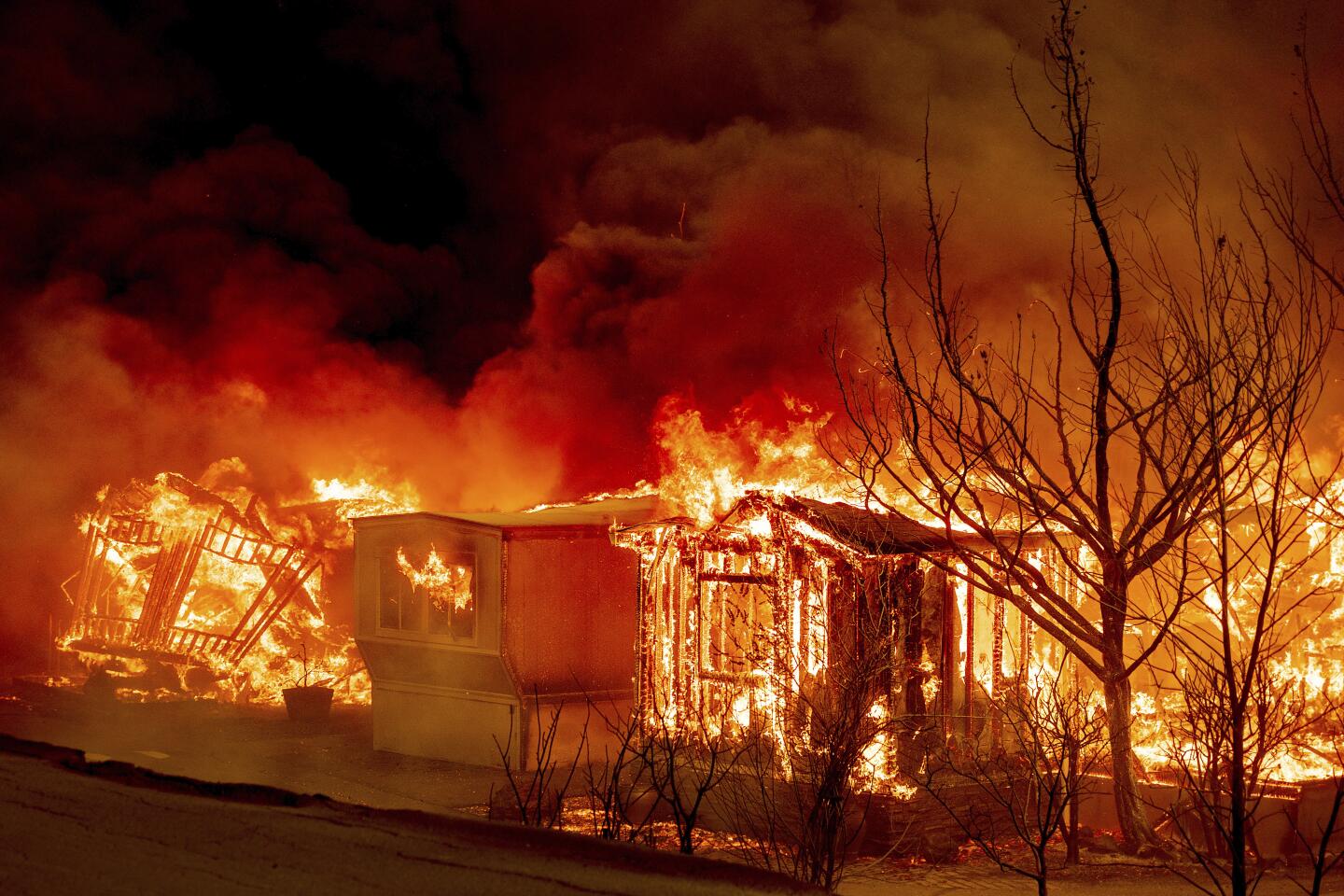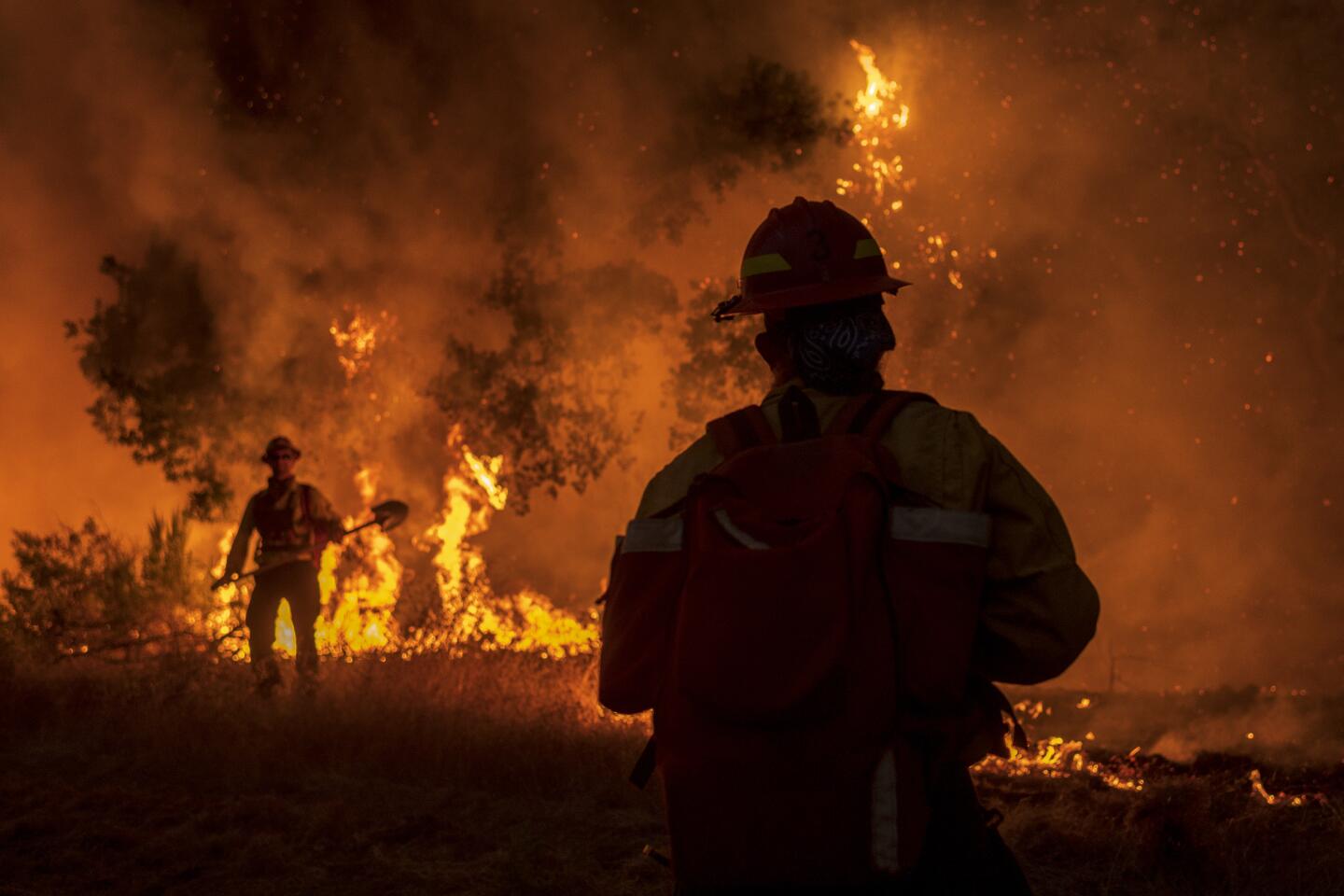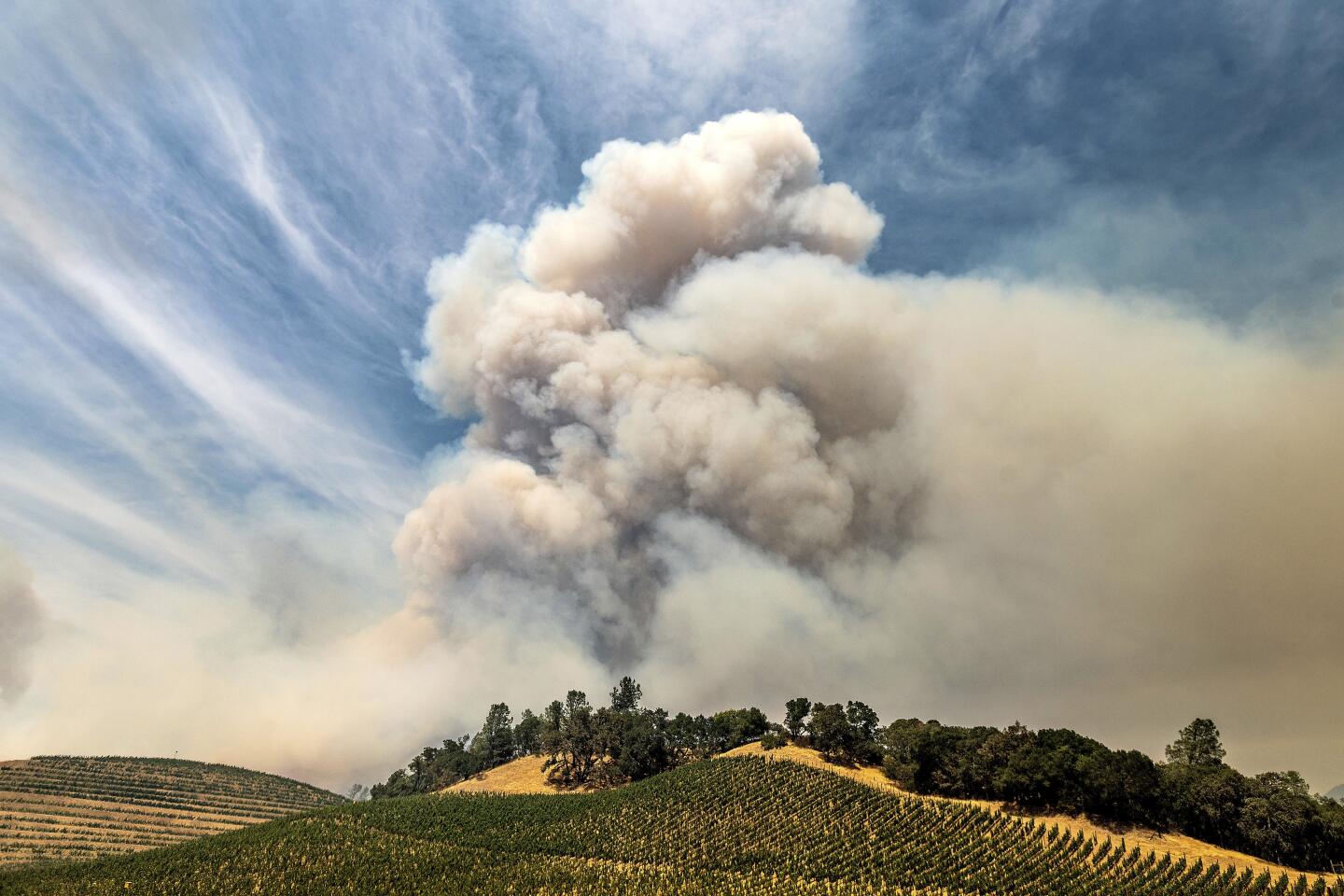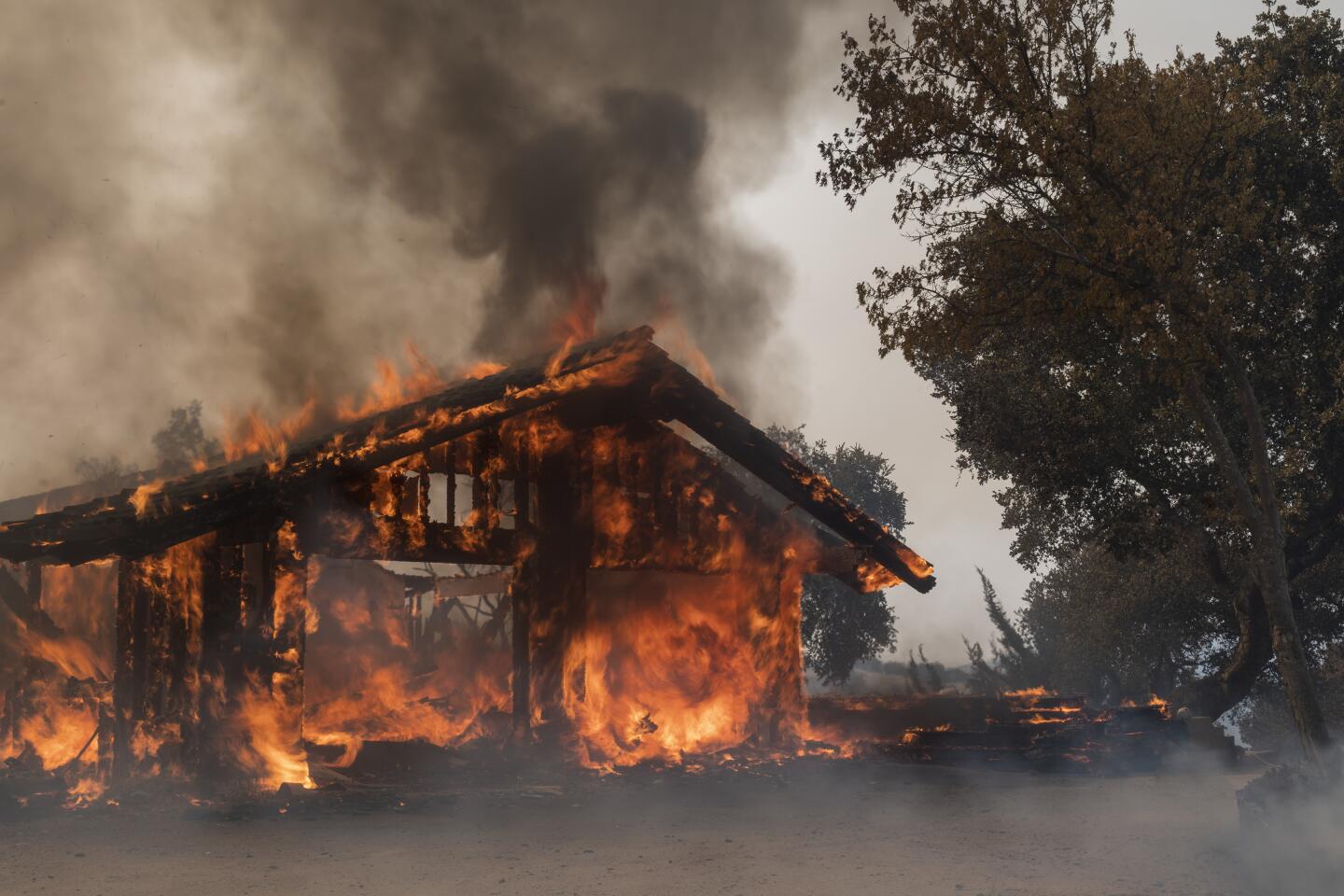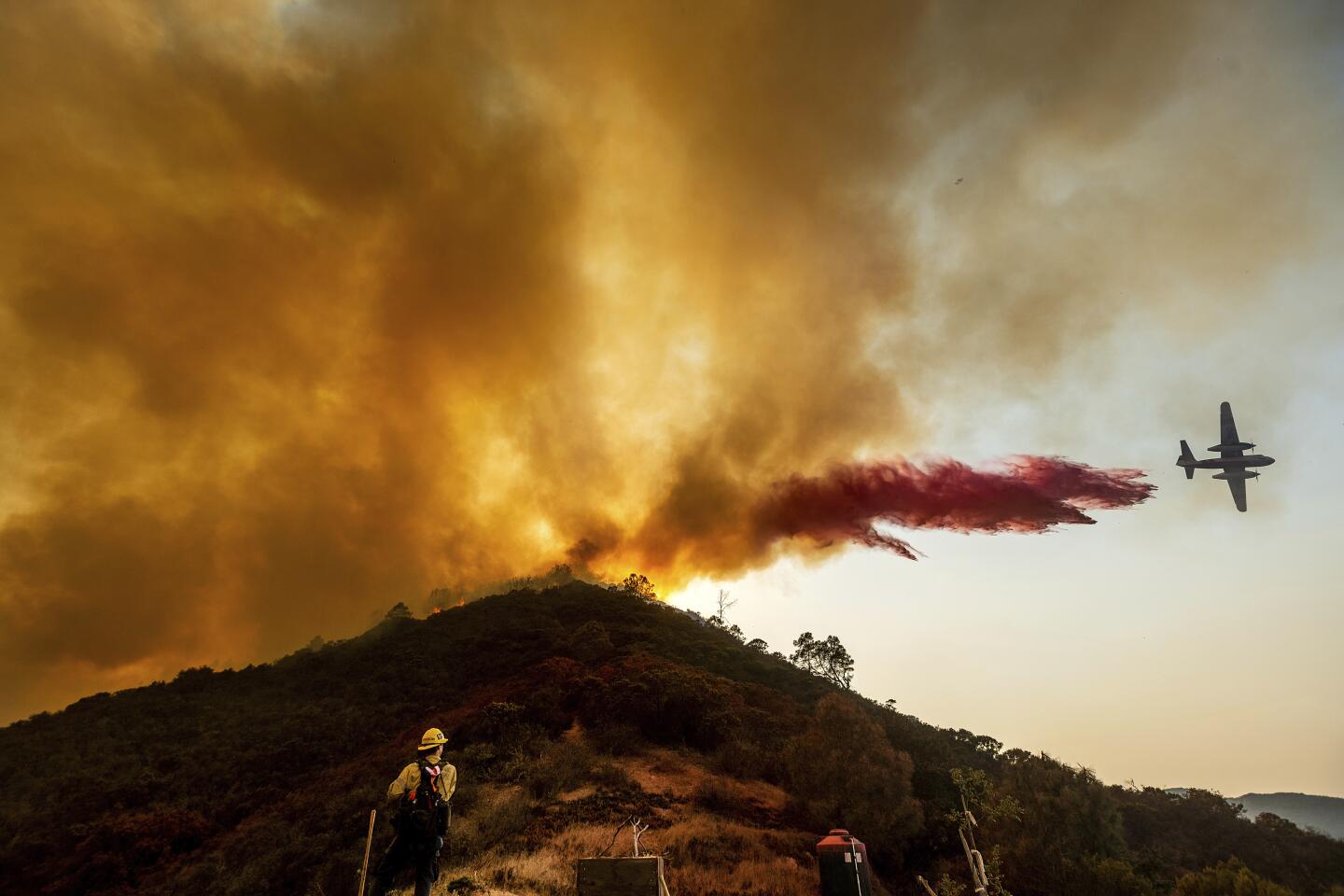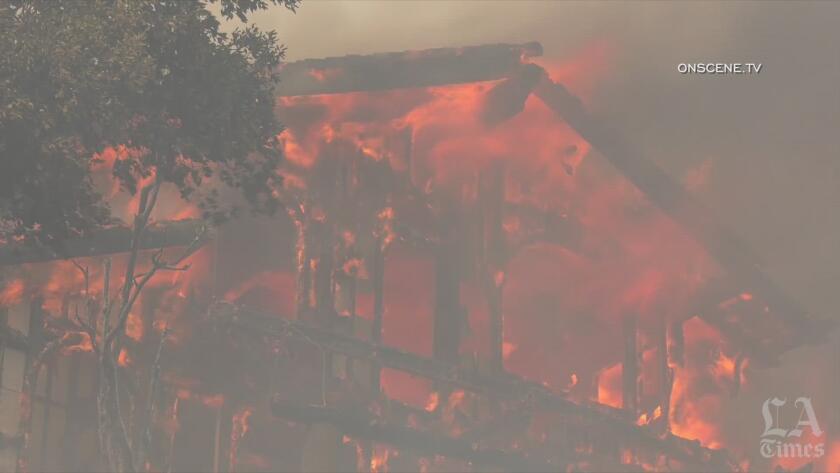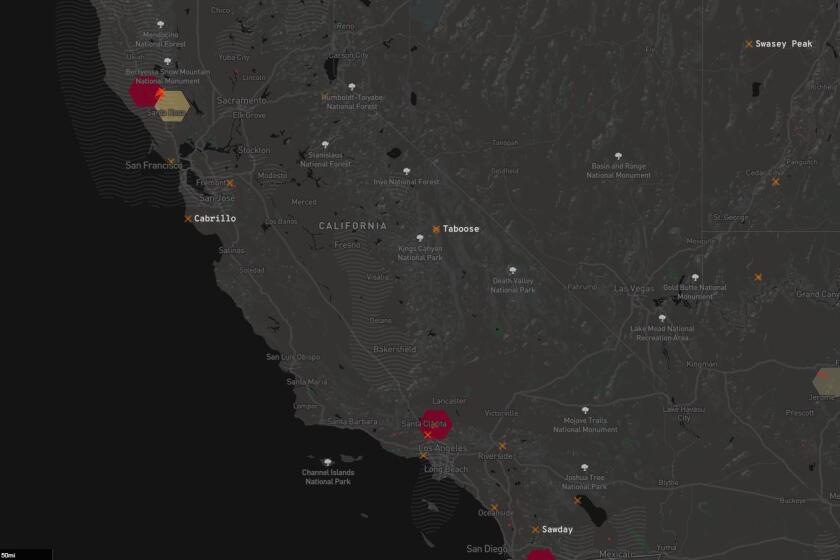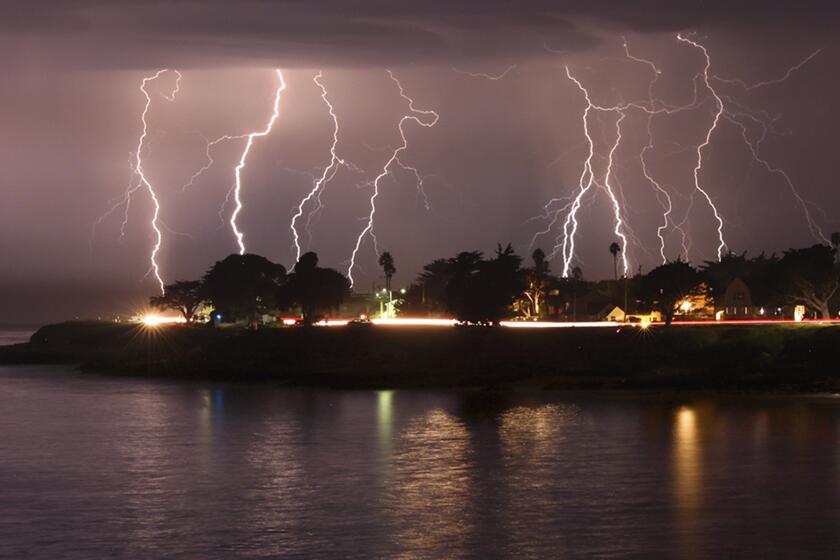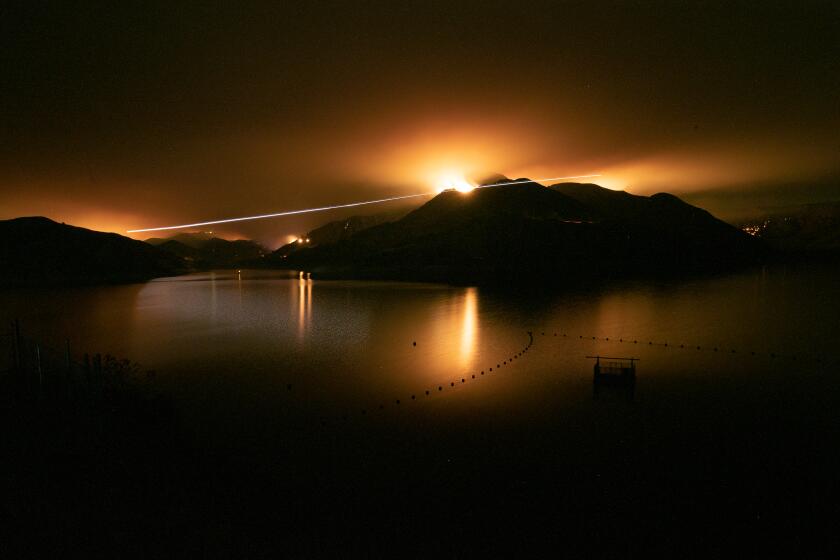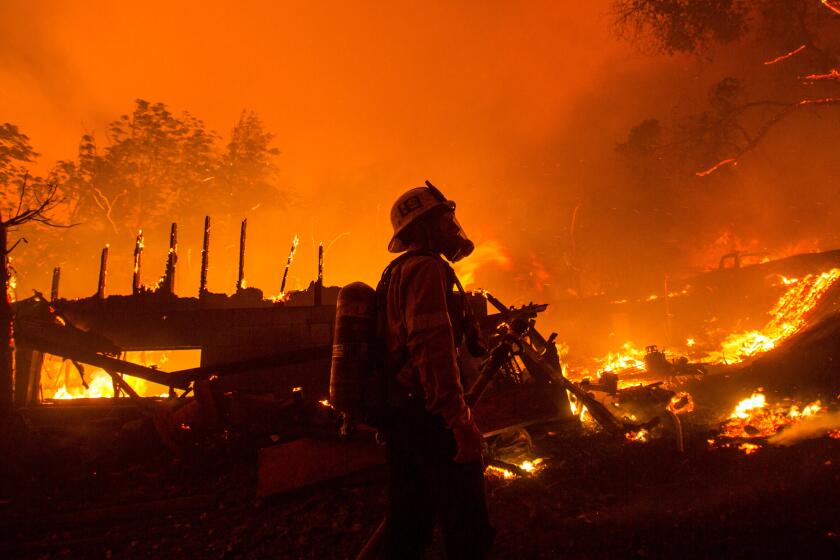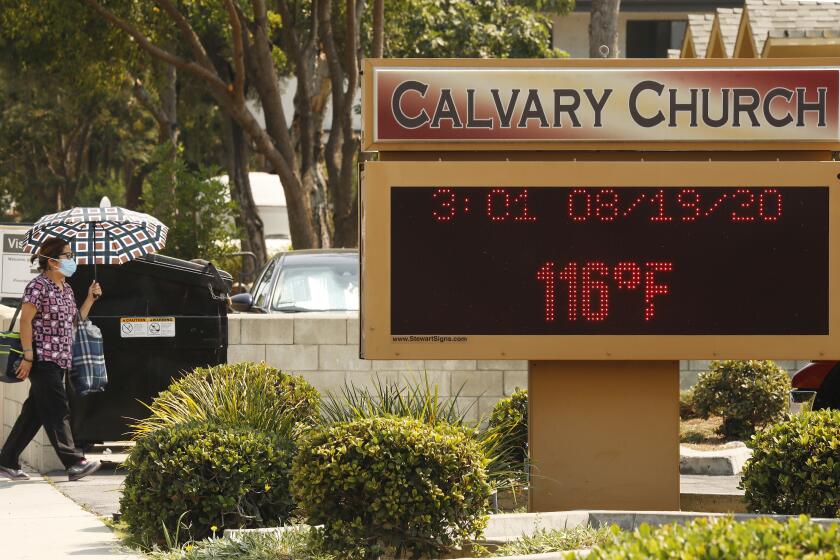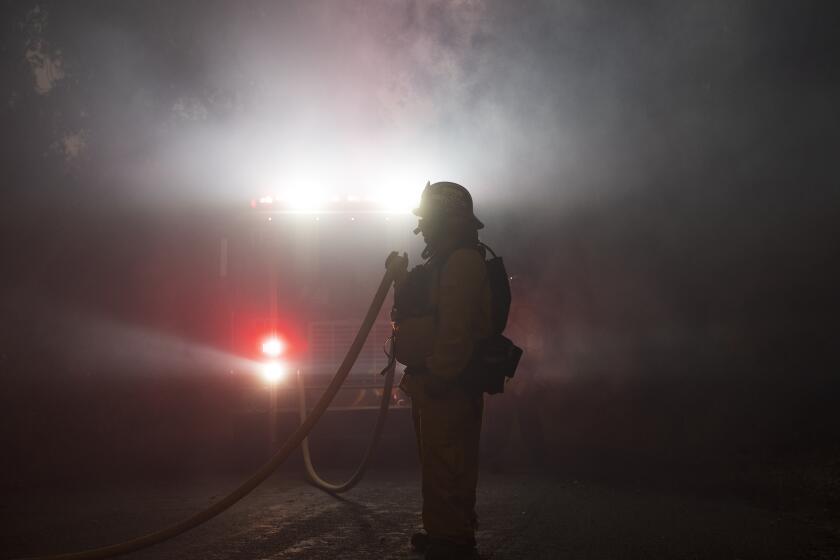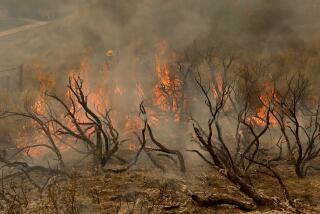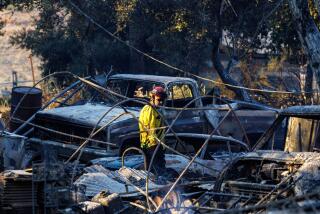Firestorm in Bay Area grows quickly to 124,000 acres, now threatening 25,000 structures
VACAVILLE, Calif. â A series of fires raging through five North Bay counties grew to more than 124,000 acres by Wednesday night, destroying more than 100 structures and threatening 25,000 others.
The firestorm was the largest of several fast-moving blazes in the San Francisco Bay Area and elsewhere in Northern California â many caused by intense lightning storms â that spread quickly overnight, burning homes and forcing thousands to flee.
The newest fires stretched from wine country to the Santa Cruz Mountains, moving with ferocious speed amid an intense heat wave that also has brought rolling blackouts. Smoke from the fires has caused terrible air quality across the region.
Many of the fires were believed to have been caused by lightning strikes. Northern and Central California began experiencing an unusually active sequence of largely dry lightning strikes Sunday morning, the most widespread and violent in recent memory in the Bay Area on one of the hottest nights in years, according to Daniel Swain, a climate scientist with UCLA and the National Center for Atmospheric Research.
The LNU Lighting Complex fire has burned more than 46,000 acres in Northern California.
Over the last 72 hours, there have been some 10,849 lightning strikes throughout California, state officials said.
As of Wednesday afternoon, 367 major fires were burning statewide, according to Gov. Gavin Newsom.
âThis fire season has been very active and, not surprisingly, that activity has taken shape in a number of counties up and down the state,â he said during a news briefing.
At this time last year, crews had responded to a total of 4,007 fires throughout the state, Newsom said. Theyâve already been dispatched to 6,754 this year.
More than 300,000 acres have burned statewide in 2020, according to the California Department of Forestry and Fire Protection. By comparison, California wildfires charred about 270,000 acres in 2019, the smallest number since 2011.
The rapid outbreak of new blazes has stretched the stateâs firefighting resources to their limit.
Jeremy Rahn, the lead Cal Fire public information officer for the LNU Lightning Complex fires, said Wednesday that the state had already requested 375 additional fire engines as well as additional hand crews from out-of-state agencies, and hired ânearly all available private firefighting âcall when neededâ aircraft in the western United States.â
âThe size and complexity at which these incidents are burning is challenging all aspects of emergency response,â he said during a media briefing. âFirefighting resources are depleted as new fires continue to ignite.â
Newsom, however, expressed confidence that California is prepared to rise to the challenge and thanked the leaders of other states â including Arizona, Nevada and Texas â for their pledges to send additional resources.
California is âputting everything we have on these fires,â he said, and âweâre now getting the support of some of our partners in the Western United States, and for that, again, weâre very grateful.â
Destructive Bay Area fires have been fueled by an unusual combination of dry lightning and extreme heat.
The LNU Lightning Complex, which has burned at least 124,000 acres, comprises several fires in Napa, Sonoma, Solano, Yolo and Lake counties.
The most serious fire in the complex is the Hennessey fire, which began Monday morning on the eastern edge of Lake Hennessey in Napa County and marched into Solano and Yolo counties Wednesday morning, forcing residents to flee overnight and burning homes and other structures.
As of Wednesday night, 105 structures had been destroyed, 70 more had been damaged and 25,000 were threatened, fire officials said.
Officials have ordered the evacuation of the western edge of Vacaville â a city of 100,000 residents about halfway between San Francisco and Sacramento. The Vacaville Fire District also ordered evacuations of Pleasants Valley Road, which lies west of the city, and the English Hills and Gibson Canyon Road areas north of the city. A KPIX-TV reporter tweeted a video of a home burning off Pleasants Valley Road.
The fire was also forcing the evacuations of some northern neighborhoods in the city of Fairfield west of Interstate 80. By Wednesday afternoon, the fire jumped Interstate 80, forcing it to shut down in both directions between Fairfield and Vacaville. The interstate reopened later Wednesday night.
Evacuation orders and warnings have also been also issued for a stretch of Highway 121 in the Vaca Mountains northeast of the city of Napa, and in the mountains about eight miles northeast of St. Helena. On Wednesday night, evacuation orders extended closer to Napa Valley, and included the communities of Angwin and Deer Park north of St. Helena.
Mandatory evacuations were also ordered Wednesday night for non-essential personnel at Travis Air Force Base in Fairfield.
And in Lake County, residents living around Hidden Valley Lake and Jerusalem Valley were ordered to evacuate as well.
More than 30 wildfires are burning across California, including nearly a dozen that started in the last two days.
The LNU Lightning Complexâs fires in Sonoma County triggered evacuation warnings on both sides of the Russian River. The Walbridge fire was burning north of Armstrong Redwoods State Natural Reserve and the community of Guerneville on the Russian River. South of the Russian River, evacuation warnings were issued as a result of the Meyers fire.
More than 30 wildfires are burning across California, including nearly a dozen that started in the last two days.
Vegetation throughout the area is extremely dry and considered to be in severe drought, according to Cal Fire.
Officials said the Walbridge and Meyers fires were likely to push southeast Wednesday as they burned through timber and the coastal forestsâ understory.
The complexâs northern fires were burning through brush and oak woodland and heading south toward Mount Vaca earlier on Wednesday.
The explosive growth of the Lake fire in Los Angeles County has raised worries about the fall fire season
The fires have sent American Red Cross staff and county workers from across the Northern California region scrambling to prepare for evacuees, said Denise Everhart, the Red Crossâ Pacific Division disaster executive.
The Red Cross has set up between 10 and 15 temporary evacuation points where residentsâ needs are assessed before theyâre sent to a hotel or motel. Everhart said that while more than 100 families were placed in rooms Tuesday night â some driving up to an hour away for lodging â itâs not a sustainable model if the evacuations continue to expand.
The LNU Lightning Complex fire may trigger up to 35,000 more evacuations, Everhart said, explaining that historically, between 1% and 3% of evacuees go to shelters.
She sought to assuage any concerns that going to a shelter could put people at risk of the coronavirus.
âWeâve put precautions in place,â she said. âIf youâre told to go, go. Weâre all working together to keep people safe. ... The fire is the risk.â
Though emergency officials have opened multiple evacuation centers in Vacaville, many of those forced to leave their homes in the middle of the night were setting up camp in parking lots instead of entering buildings.
Those with RVs had generators up and running and their front awnings open. Others sat in folding chairs by their cars or in their front seats. Still more had already checked into local hotels, where rooms were filling fast.
Shawnee Whaley and her 79-year-old mother, Sharon Whitaker, sat inside an evacuation center Wednesday afternoon wrapped in American Red Cross blankets.
Whaley said they had no warning that the fire might be a threat when they went to sleep Tuesday night. But when Whaley was woken up by a phone call from a friend and saw that the power was out, she flung open her front door and âsaw the glow of the fire.â She used a ladder to climb onto her roof and spotted flames approaching.
Barefoot and still wearing pajamas, she ran across the street to her motherâs trailer to wake her. Whaley grabbed a mask and her glasses but forgot her wallet. She left the front door open so her cat, Jitterbug, could hopefully escape.
Meanwhile, Lloyd Broughton, 78, evacuated after a firetruck came up his road at 3 a.m. He, his wife Anne, 73, and daughter Kristine, 35, gathered their seven rescue cats and packed two cars.
All three suffer from breathing problems and, with a heavy layer of ash falling, they were already coughing and having trouble, Kristine said.
While evacuating during a fire is always a stressful experience, itâs been made all the more so because of the coronavirus outbreak â which has raised new fears among displaced residents who would normally pack into closely quartered emergency shelters and created new challenges for the agencies that operate them.
âNo one is ready for it,â Broughton said of having to leave in the middle of a pandemic.
Another rapidly growing fire was burning in the mountains southwest of Silicon Valley, on the border of San Mateo and Santa Cruz counties. The CZU August Lightning Complex fire â which consists of 22 fires â has burned at least 25,000 acres and forced the evacuation of more than 22,000 people, officials said Wednesday night.
Evacuations were ordered around Big Basin Redwoods State Park, AĂąo Nuevo State Park, Butano State Park and Pescadero Creek Park. Other evacuations included the area around Bonny Doon. Evacuations centers were set up at the Santa Cruz County Fairgrounds in Watsonville and at Pescadero High School.
At least 20 structures, likely single-family homes, have been destroyed, officials said during a Wednesday evening press conference. In San Mateo County, the CZU August Lightning Complex fire was threatening the communities of Pescadero and La Honda. In Santa Cruz County, structures have been lost in the Swanton Road area, and a Cal Fire station was being threatened by flames.
Firefighters expressed worry about the fire reaching the communities of Boulder Creek, Ben Lomond and Felton, located northwest of Santa Cruz. The weather conditions for the next three days are grim, said Mark Brunton of Cal Fire.
âThat makes that threat very direct and very real,â he said. âWeâre doing everything we possibly can to protect life and property.â
Rita Mancera, the executive director of Puente, a community organization based in Pescadero, was at the evacuation center at Pescadero High School on Wednesday helping evacuees locate hotel rooms and provide logistics for pets and livestock.
Among those fleeing the CZU August Lightning Complex fire was Steve Cobb of Dearborn Park. He evacuated his home Tuesday evening, with his wife, 14-year-old daughter, dog and two cats. They packed into their camper, already stocked from a recent trip to Yosemite, and headed to the beach.
Cobb moved to Dearborn Park 17 years ago and said that as a Bay Area native, heâs never witnessed anything like what heâs seen in the last few days.
âThose storms were not ordinary,â he said. âThey were tropical... Constant flashes of light, crashing thunder and rain.â
Some residents looked for ways to help others threatened by the fire.
At home with his wife, three kids and 40-acres of hay farm, Jeff Moorehead of Vacaville put out a message on a local Facebook group at about 6 a.m. inviting anyone with livestock to bring their animals to their place. Eventually, Moorehead had about 25 new animals at his farm.
âWe got alpacas, miniature horses, a little bit of everything,â he said with a chuckle.
Offering relief to animal owners has become a regular part of his response to local wildfires, he said. In 2017, he helped shuttle animals from the Atlas fire in Napa County to Vallejo in Solano County.
âYou have empathy for animals a lot of times and you have the same empathy for people,â he said.
On Tuesday, Gov. Gavin Newsom declared a statewide emergency in order to help California respond to the outbreak of fires.
Newsomâs office said the state had secured assistance from the Federal Emergency Management Agency to respond to fires in Napa, Nevada and Monterey counties.
âWe are deploying every resource available to keep communities safe as California battles fires across the state during these extreme conditions,â Newsom said. âCalifornia and its federal and local partners are working in lockstep to meet the challenge and remain vigilant in the face of continued dangerous weather conditions.â
The rash of fires has also led to a spike in traffic to Cal Fireâs website, overloading it and intermittently crashing it, officials said. Cal Fire personnel were working with their technology department Wednesday morning to try to handle the crush of visitors.
Temperatures werenât quite as high Wednesday, but a heat warning remains in effect and Californiaâs electrical grid operator urges conservation.
By Wednesday, another blaze, dubbed the Dolan fire, has grown to at least 2,500 acres and had prompted evacuations in Monterey County near Big Sur.
As of Wednesday morning, the fire was âactively burning in all directions,â according to Los Padres National Forest officials. Because of the fire, Highway 1 was been closed from Ragged Point in San Luis Obispo County to Julia Pfeiffer Burns State Park in Monterey County, officials said.
The River fire, also in Monterey County, burned through more than 15,000 acres in steep mountainous terrain south of Salinas and destroyed six structures and damaged two others, according to Cal Fire. More than 2,750 structures remain threatened by the blaze, which has prompted mandatory evacuations.
The River fire was spreading to the north, fanned by downsloping winds and getting closer to homes on Las Palmas Parkway south of Salinas, said Greg Bertelli, the Cal Fire deputy incident commander. It was also spreading to the south.
Just south of the River fire is the Carmel fire, fanned by winds from the northwest pushing flames to the southeast, Bertelli said.
A cluster of fires is also burning in sparsely populated, mountainous terrain east of Silicon Valley and the East Bay and west of the Central Valley. This grouping, the SCU Lightning Complex fire, began early Sunday. It has burned at least 102,000 acres in five counties â Alameda, Contra Costa, Santa Clara, Stanislaus and San Joaquin. Officials have issued evacuation orders for all counties and established evacuation centers at Creekside Middle School in Patterson and the Milpitas Library.
Authorities reported 5% containment on that fire Wednesday night.
Another blaze, which authorities named the 3-4 fire, was reported Wednesday morning southwest of Red Bank Road in Tehama County and has already burned 1,000 acres, according to Cal Fire.
To the southwest, in Glenn County, the August Complex fire rapidly grew overnight into Wednesday morning, and by nightfall was at least 65,000 acres, threatening the tiny town of Elk Creek, according to the U.S. Forest Service. The August Complex fire, which consists of at least 35 blazes, was caused by lightning strikes on Sunday in the Mendocino National Forest.
The western section of Glenn County has been placed under a mandatory evacuation order. Smoke could be seen on Interstate 5 from Willows, the county seat of Glenn County, to Red Bluff, the county seat of Tehama County.
In Marin County, the Woodward fire â more than 1,000 acres â was burning in the Point Reyes National Seashore west of Olema.
And in Fresno County, a firefighting helicopter crashed Wednesday morning while on a water-dropping mission for the 1,500-acre Hills fire, killing the pilot, according to the California Department of Forestry and Fire Protection.
The helicopter was privately owned and contracted with the state to help fight fires, and the crash sparked a brush fire that has grown to about 50 acres and is spreading toward the Hills fire, officials said.
The numerous fires are blanketing the Bay Area with smoke and ash, wreaking havoc on local air quality.
Those with lung disease, asthma or other respiratory conditions should be especially careful to avoid smoky air, as should older adults and young children, said Dr. Grant Colfax, San Franciscoâs public health director.
âThe best thing you can do is to avoid outdoor air,â San Francisco Mayor London Breed said.
Particulate pollution is rife in the San Francisco Bay Area following numerous lightning-sparked fires. Intense heat is triggering ozone smog alerts elsewhere.
The South Coast Air Quality Management District also has issued smoke advisories through Wednesday afternoon for residents in the area of the Ranch 2 fire, which is burning near Azusa, as well as the Lake fire near Lake Hughes.
Firefighters are battling flames amid a heat wave that began late last week and has set record-high temperatures across California. On Sunday, the mercury in Death Valley reached 130 degrees â possibly the highest temperature reading on Earth in almost 90 years.
Temperature records for the day were broken across California on Tuesday, with Woodland Hills hitting 112, breaking a record last set for Aug. 18 in 1949; Burbank reaching 109 degrees, shattering a record last set in 1986, when the mercury hit 100; and Santa Ana, which hit 106 degrees, breaking a record last set in 2010, when the high for the day was 95.
Toward a more sustainable California
Get Boiling Point, our newsletter exploring climate change, energy and the environment, and become part of the conversation â and the solution.
You may occasionally receive promotional content from the Los Angeles Times.
Death Valley also hit a record high for the date, reaching 126 degrees, breaking the high of 125 set in 2001.
Other spots that reached record temperatures for the day included Needles (118), Barstow (113), Paso Robles (111), Sacramento (109), Merced (107), Modesto (106), Anaheim (105), Gilroy (104), El Cajon (102), Long Beach (100), UCLA (97), Camarillo (95), Oxnard (90) and Newport Beach (87). Riverside hit 108, tying a record for the day last set in 1950.
Lin reported from San Francisco, Chabria from Vacaville, Rust from Pescadero, and Money and Serna from Los Angeles. Times staff writers Leila Miller and Colleen Shalby contributed to this report.
More to Read
Sign up for Essential California
The most important California stories and recommendations in your inbox every morning.
You may occasionally receive promotional content from the Los Angeles Times.
